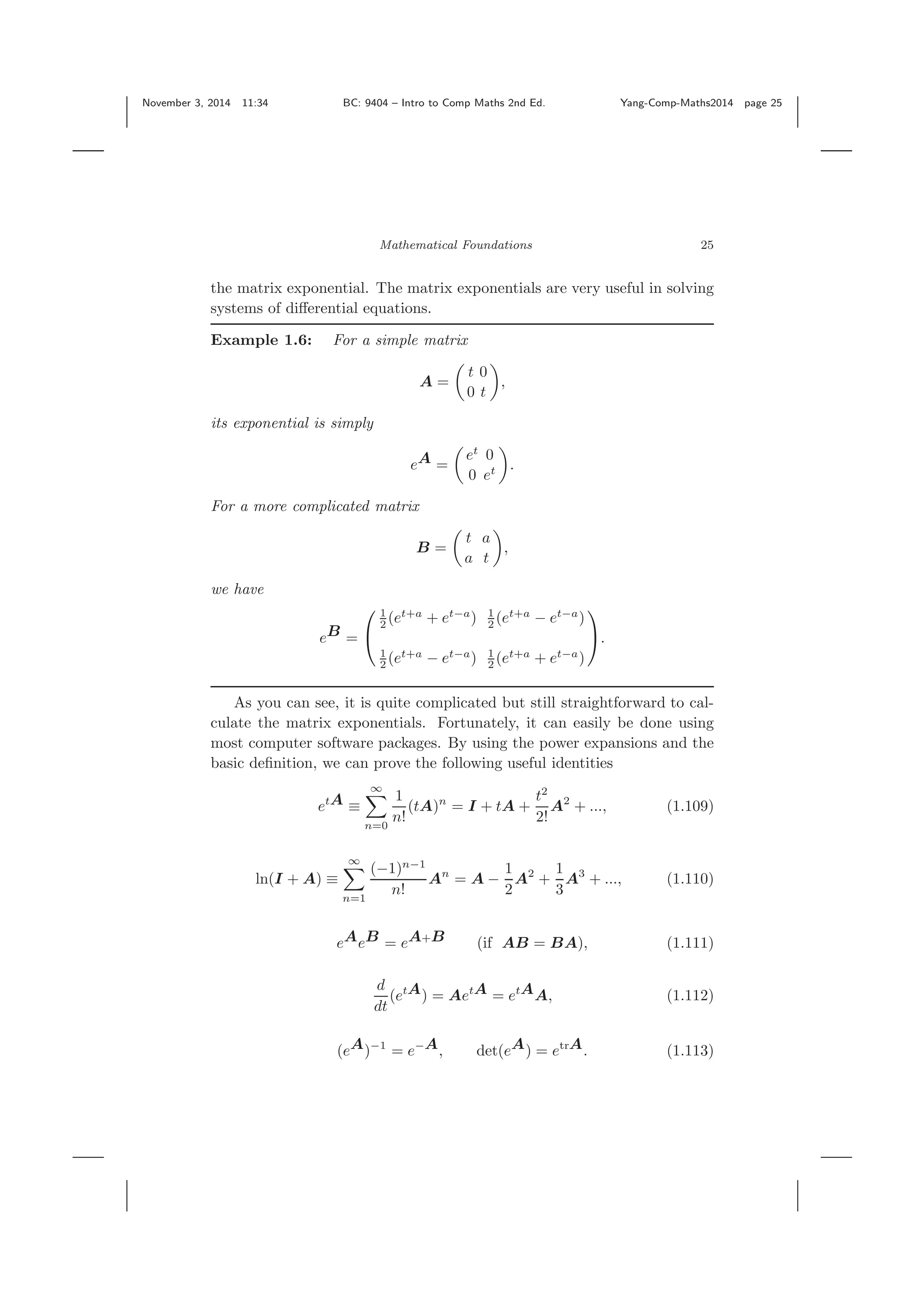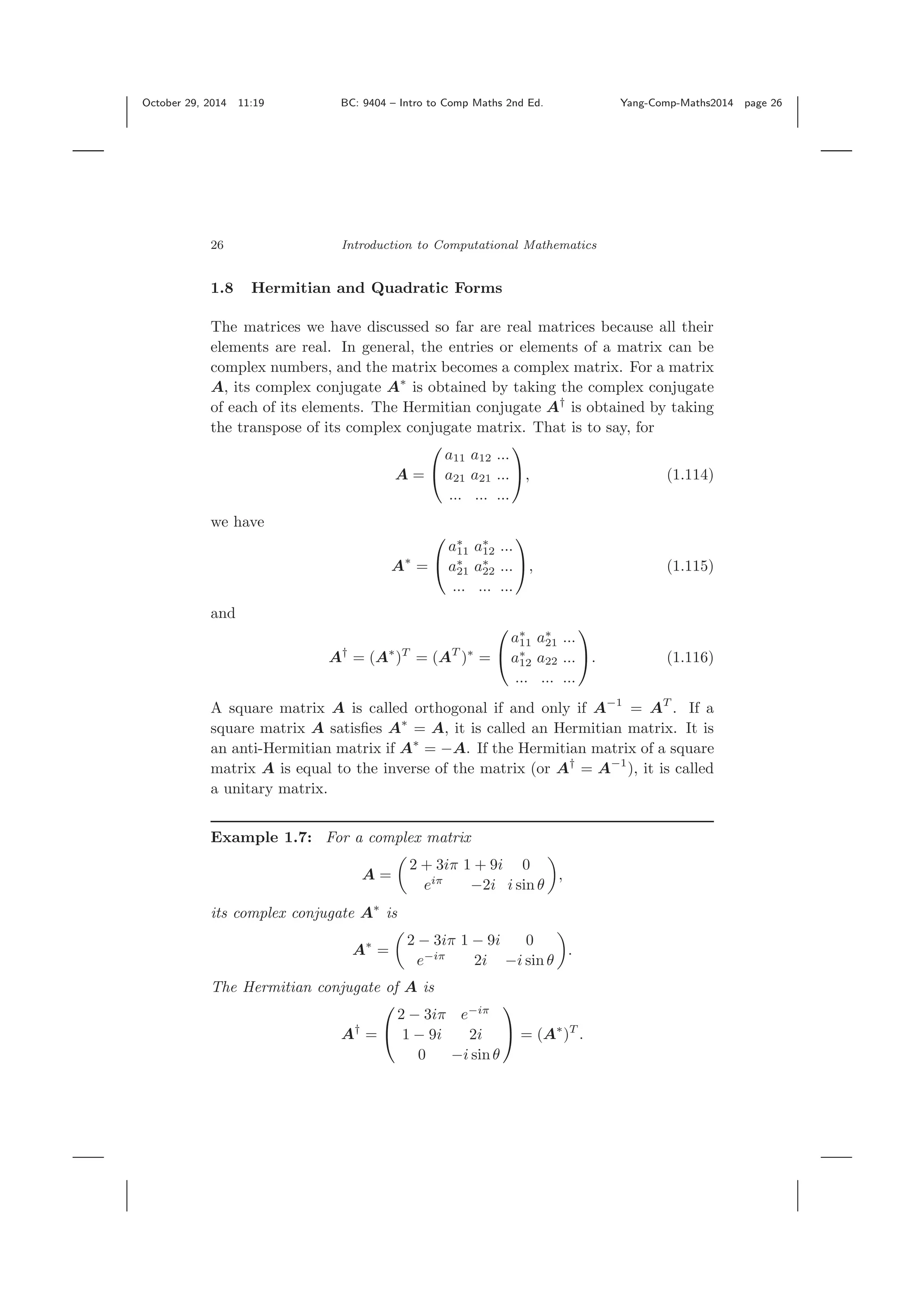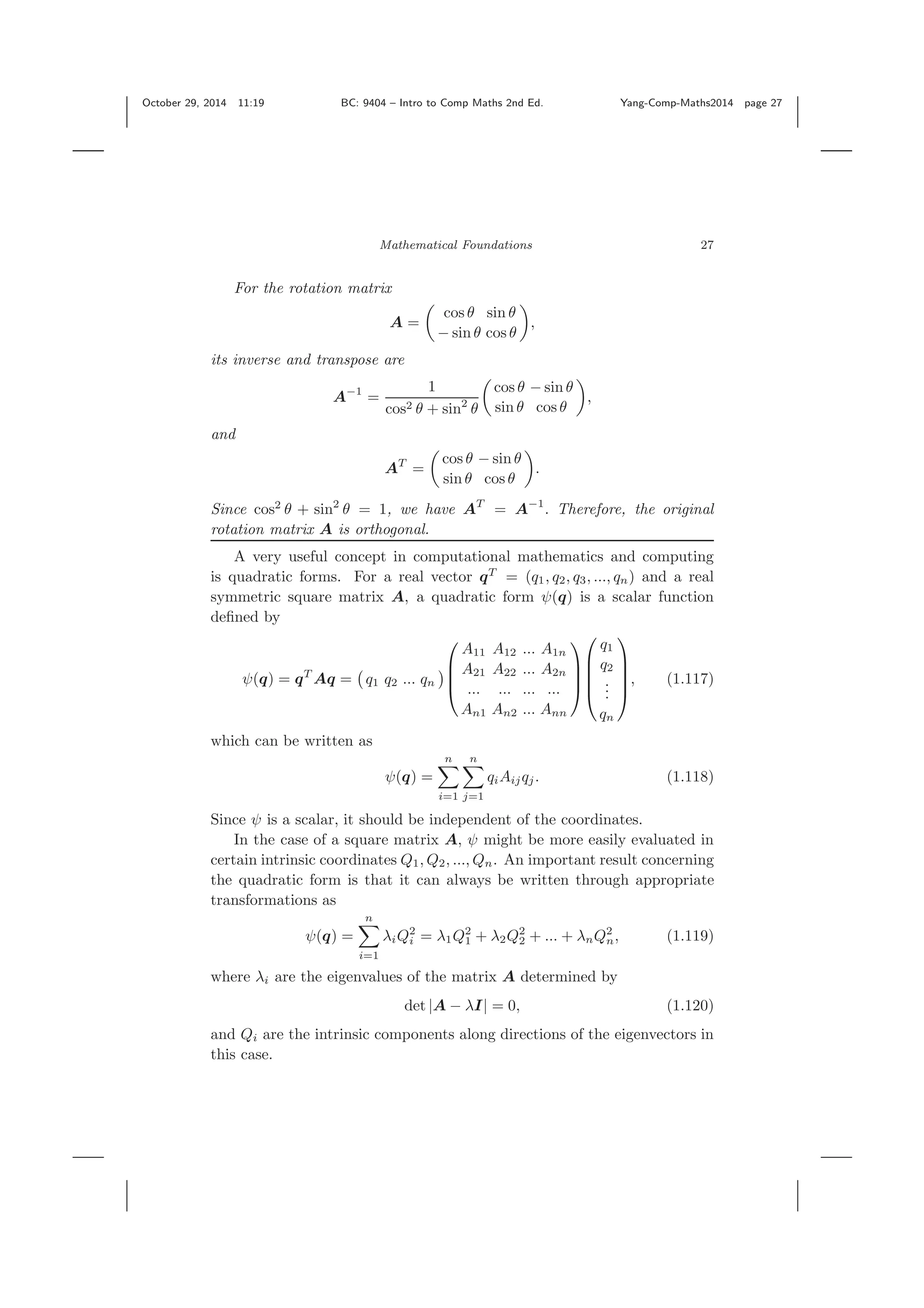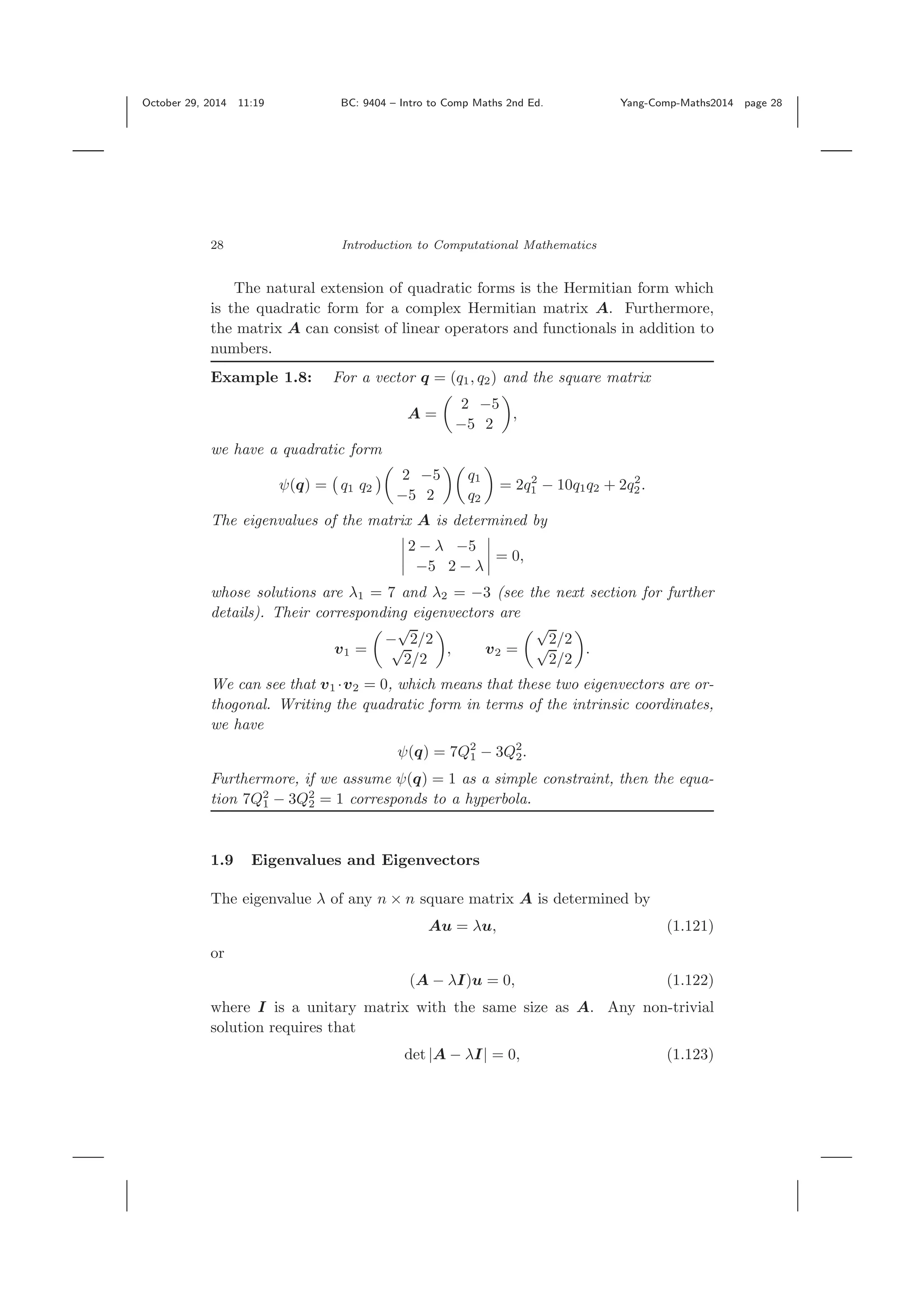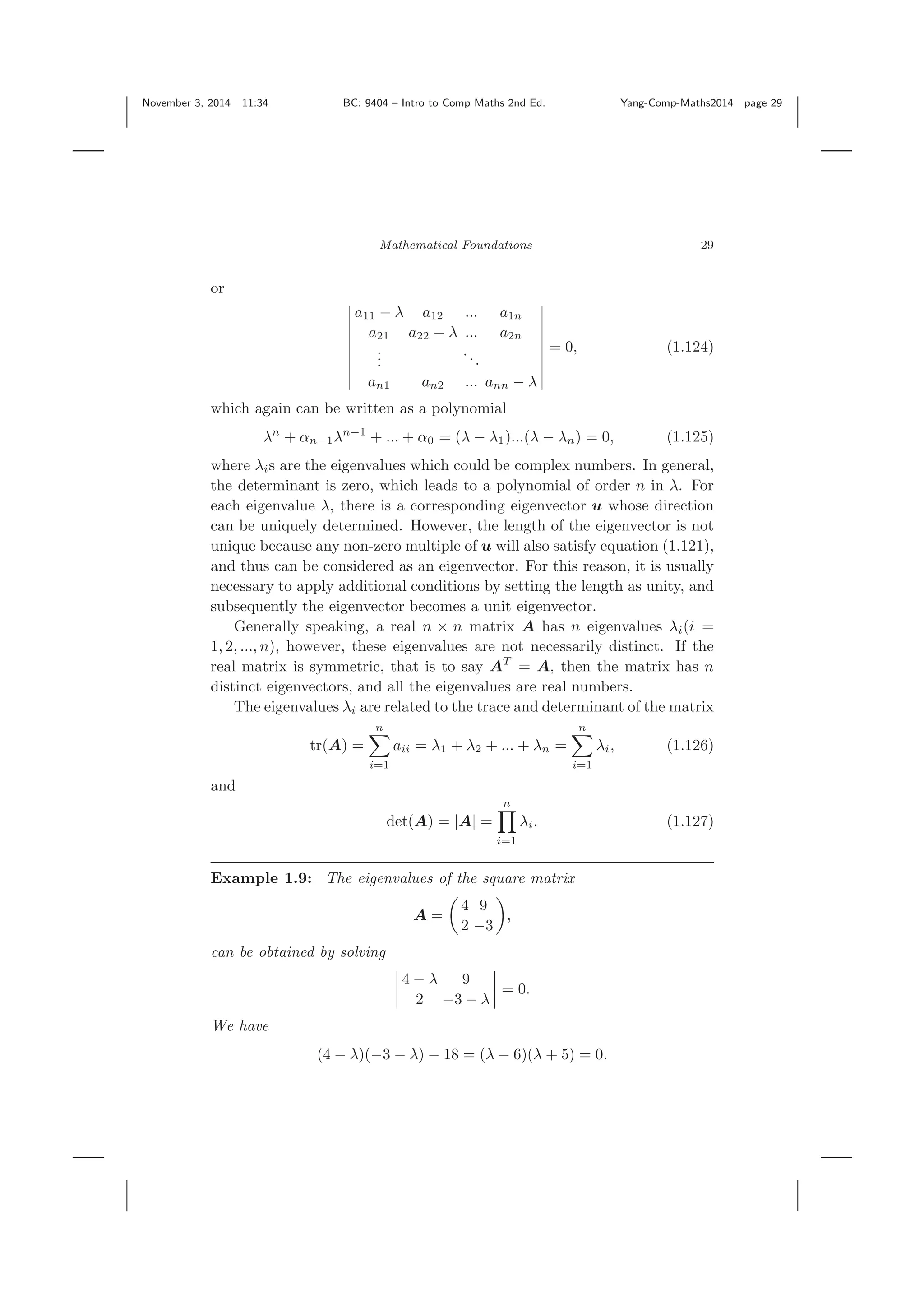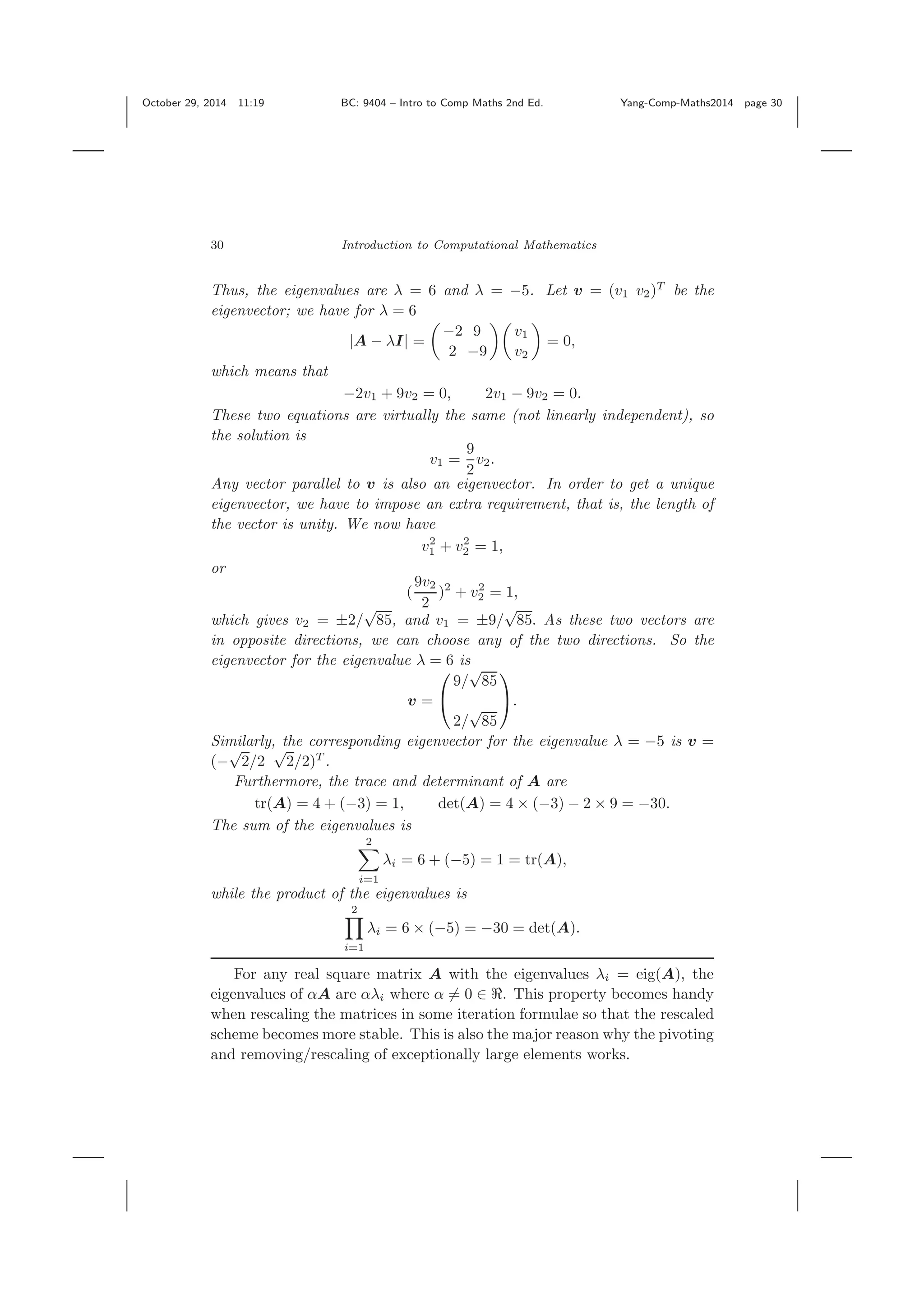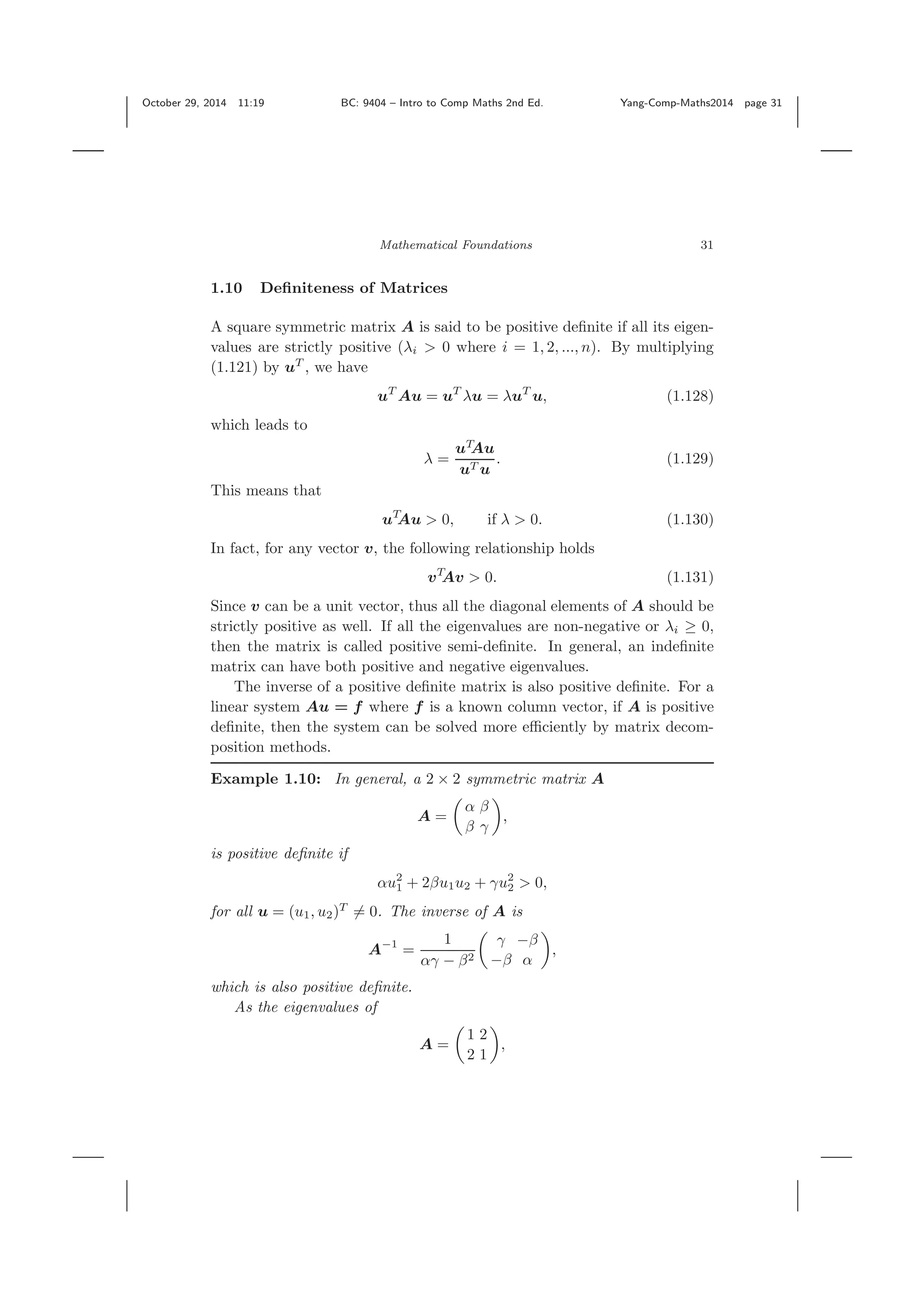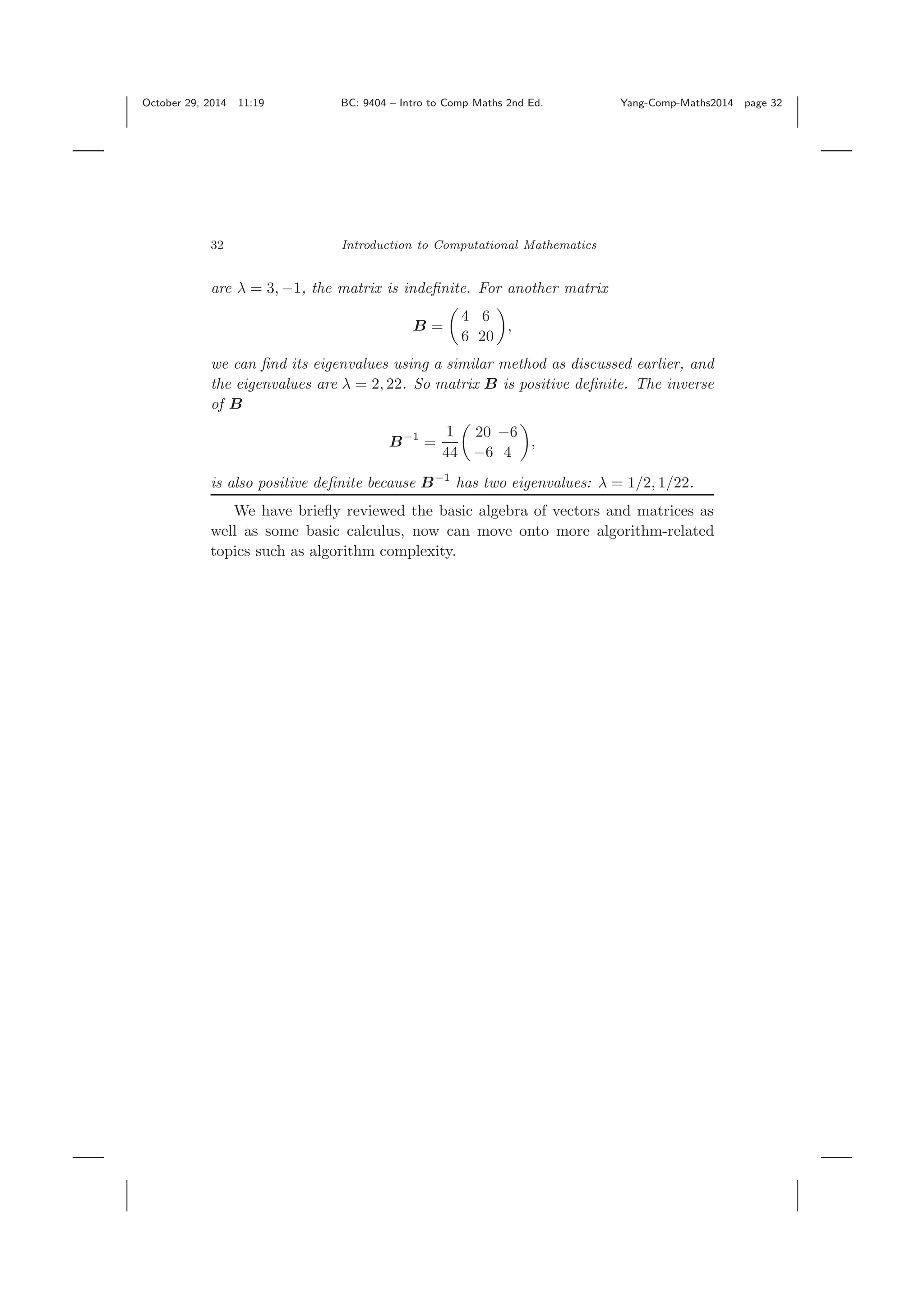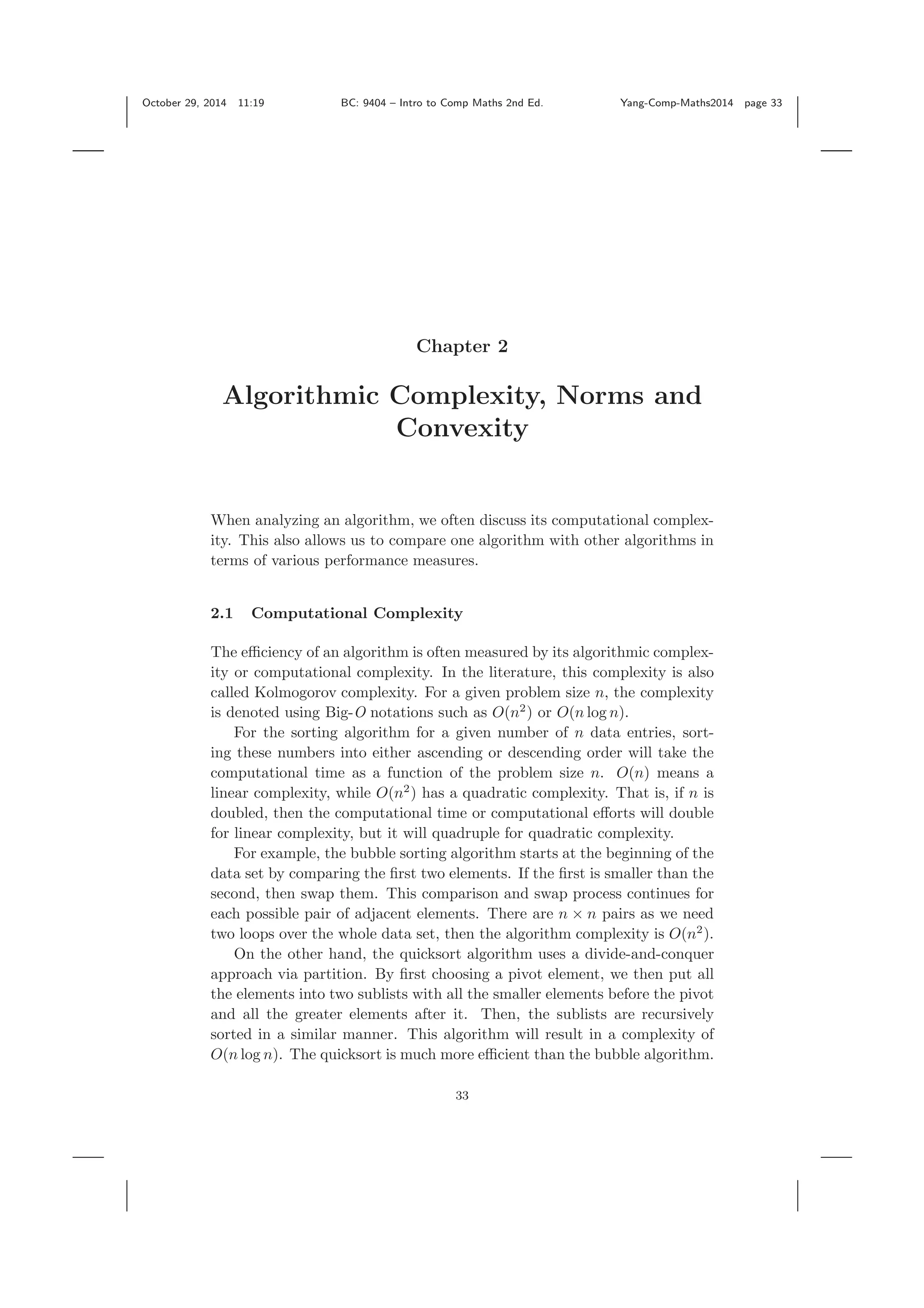The document is a preface to the second edition of 'Introduction to Computational Mathematics' by Xin-She Yang, emphasizing the significance of computational mathematics as a foundation for scientific computing and computer simulation. It addresses the historical development of numerical algorithms, their applications, and the necessity of teaching diverse algorithms in educational settings. The second edition incorporates new methodologies, enhancing its coverage of conventional and modern algorithms applicable in various scientific and engineering disciplines.
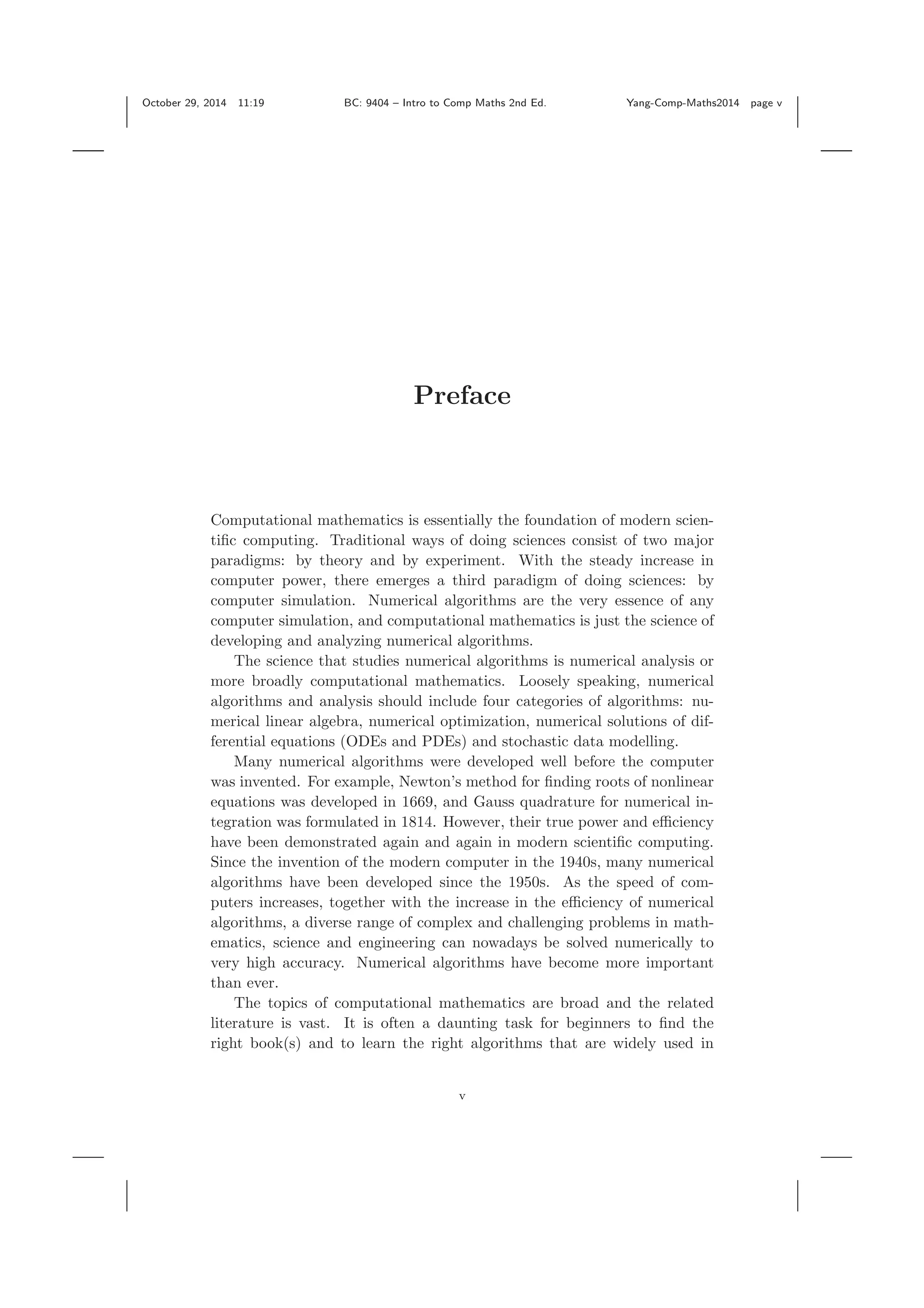
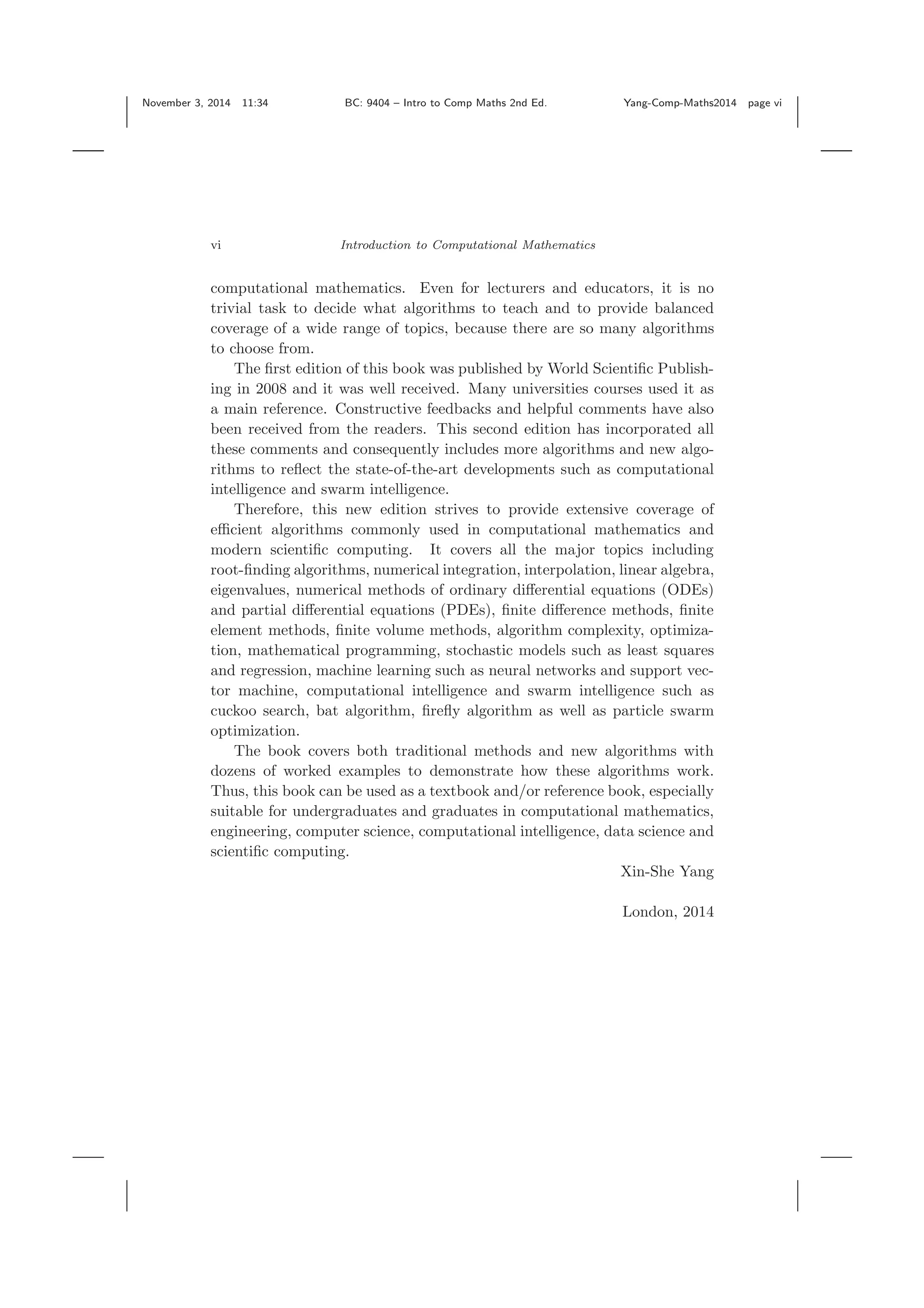
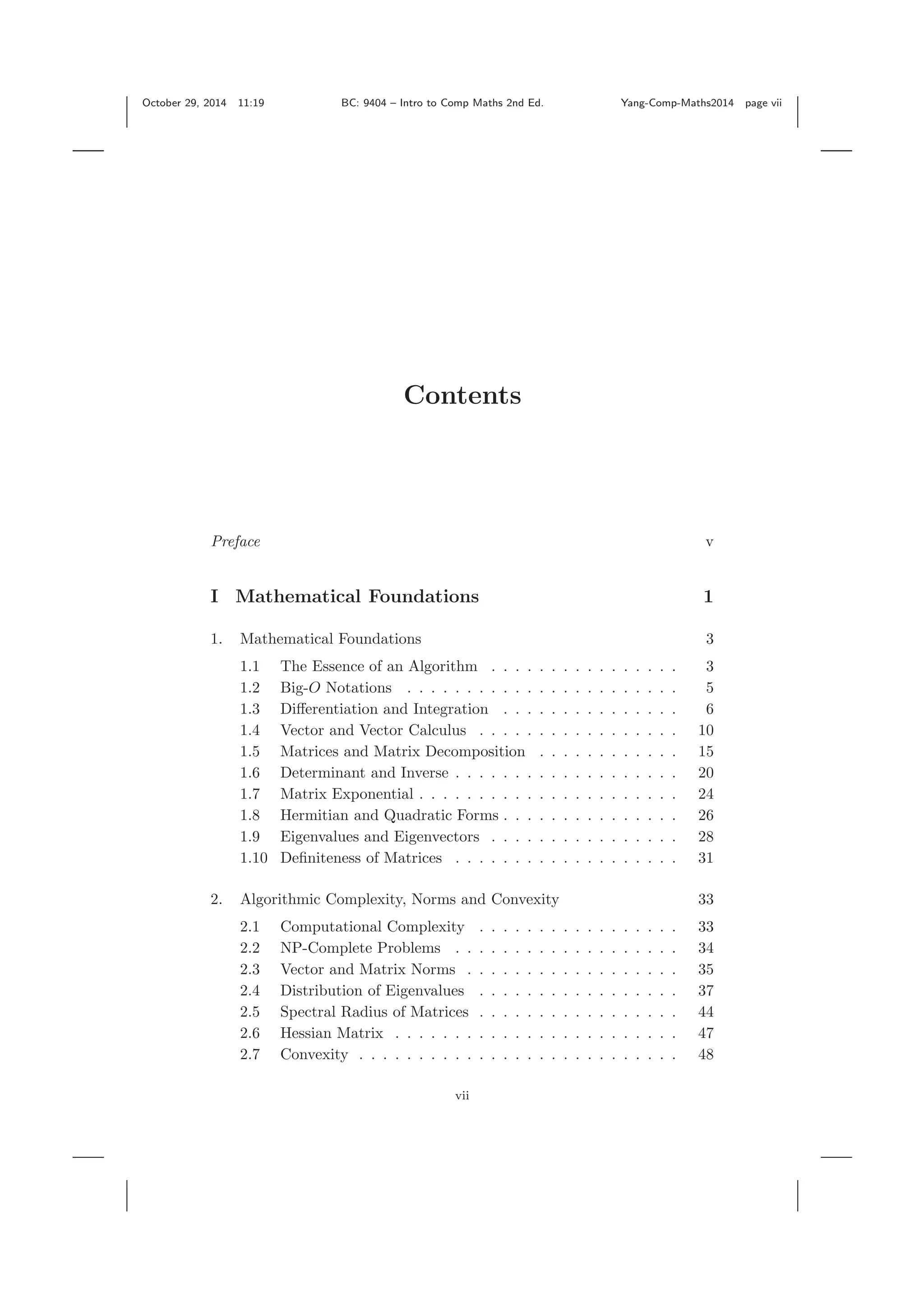
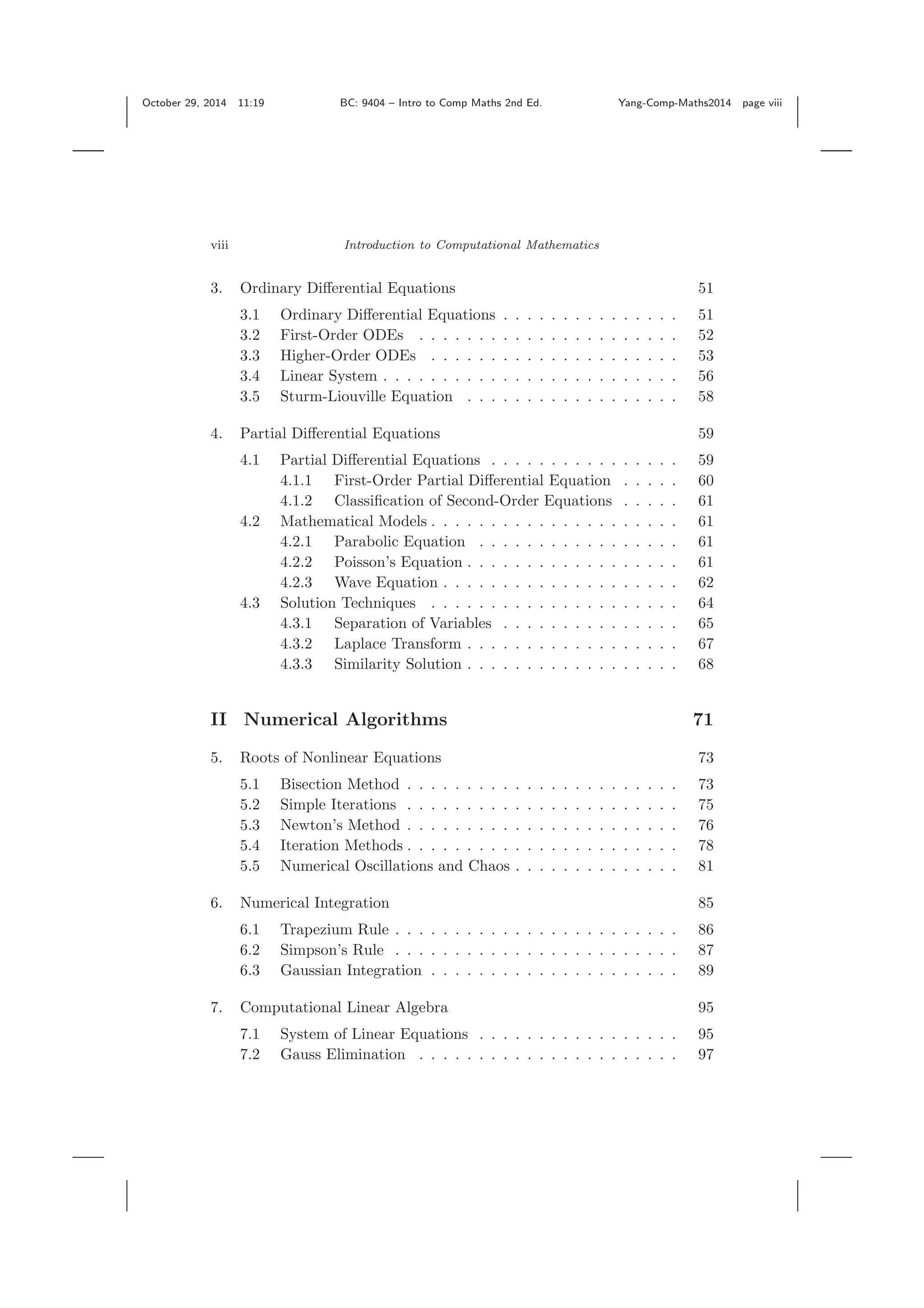
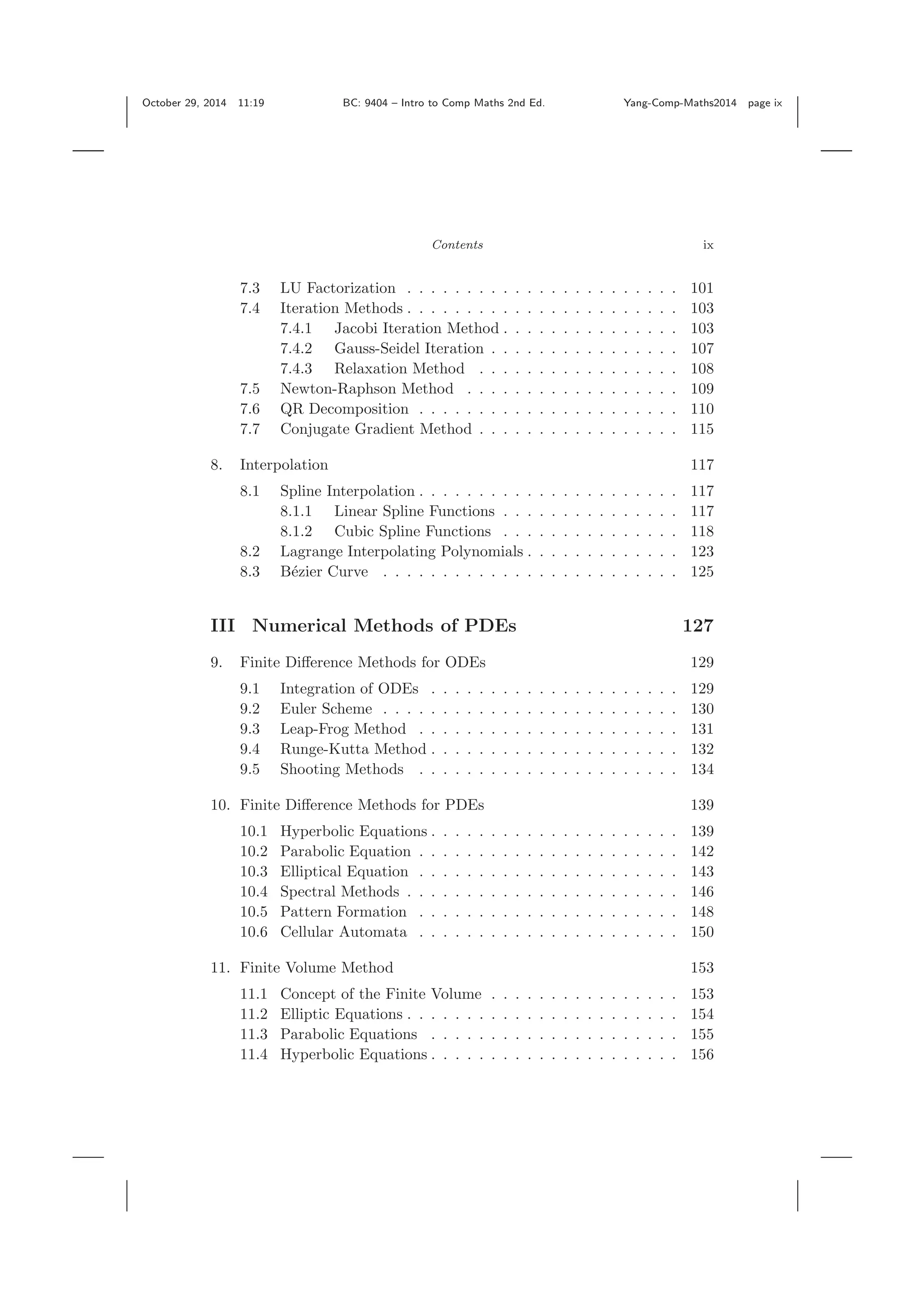
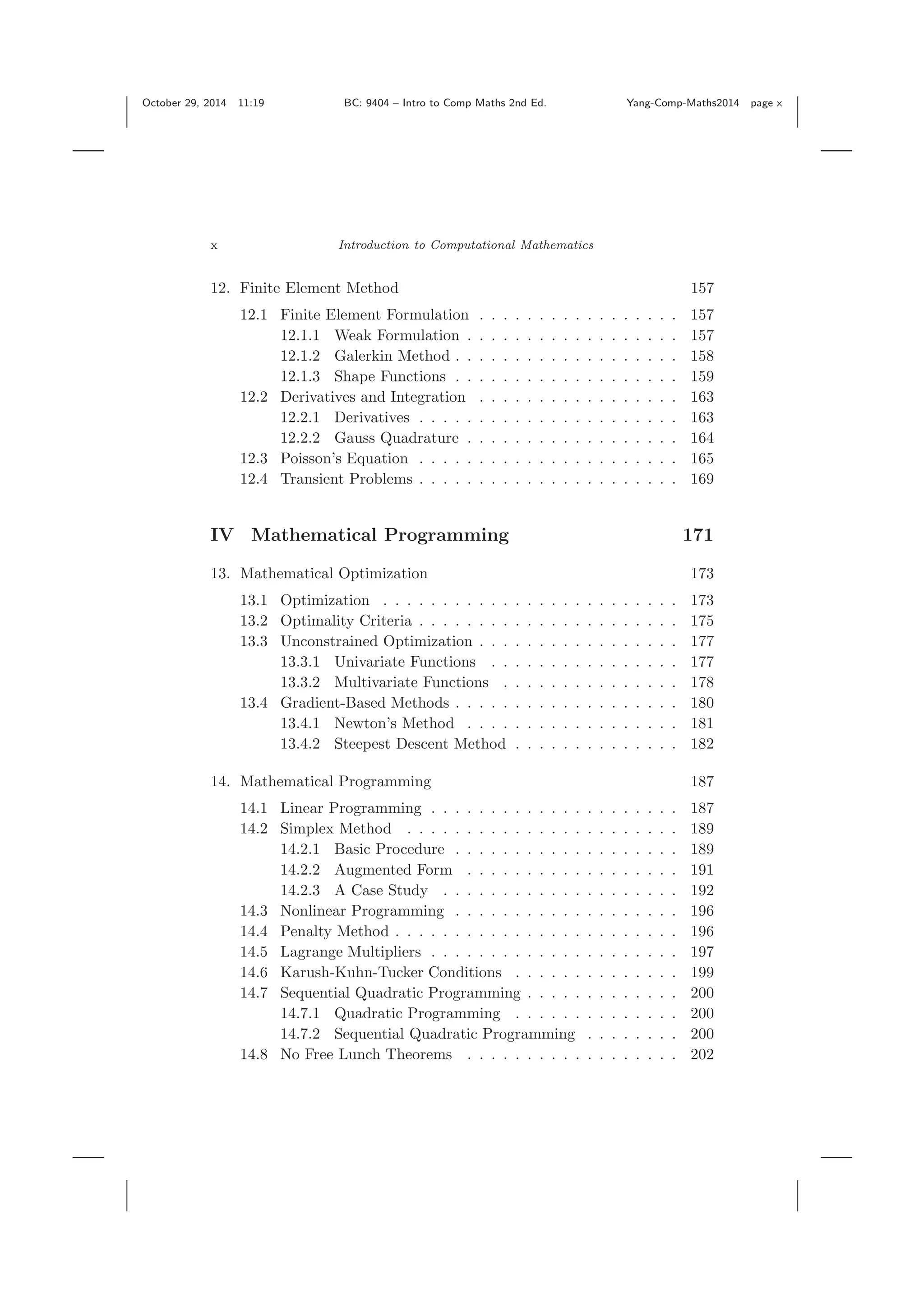
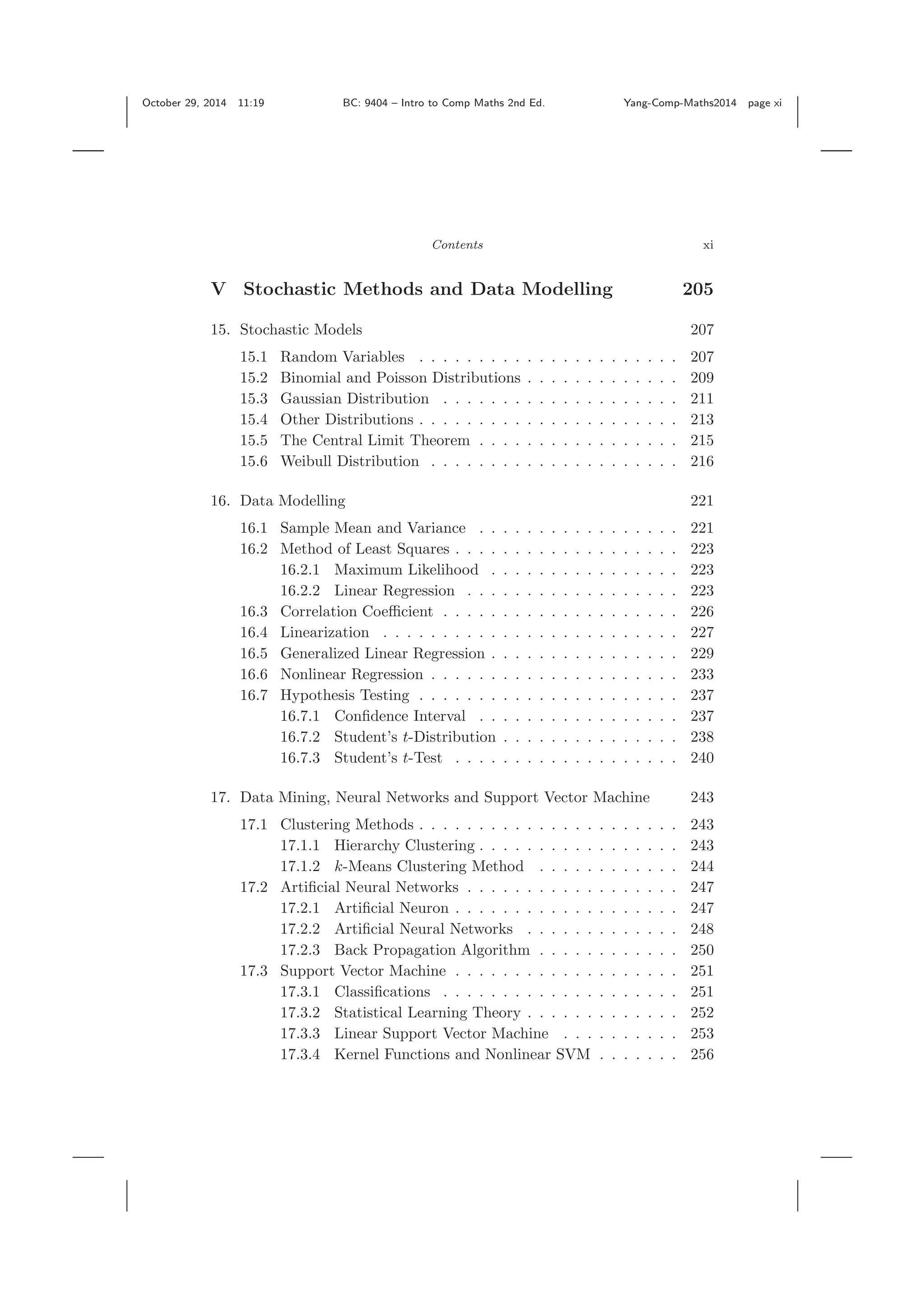
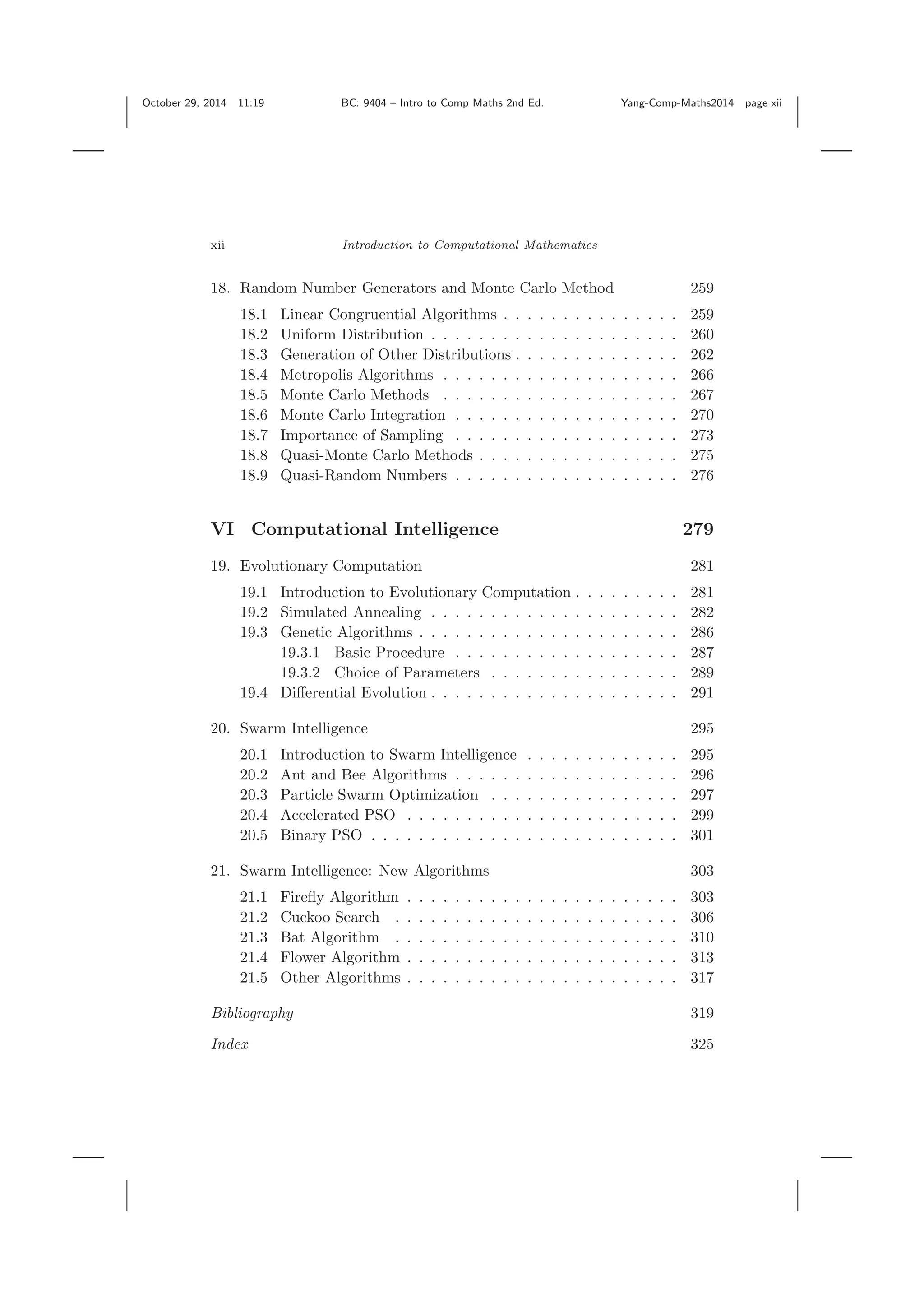
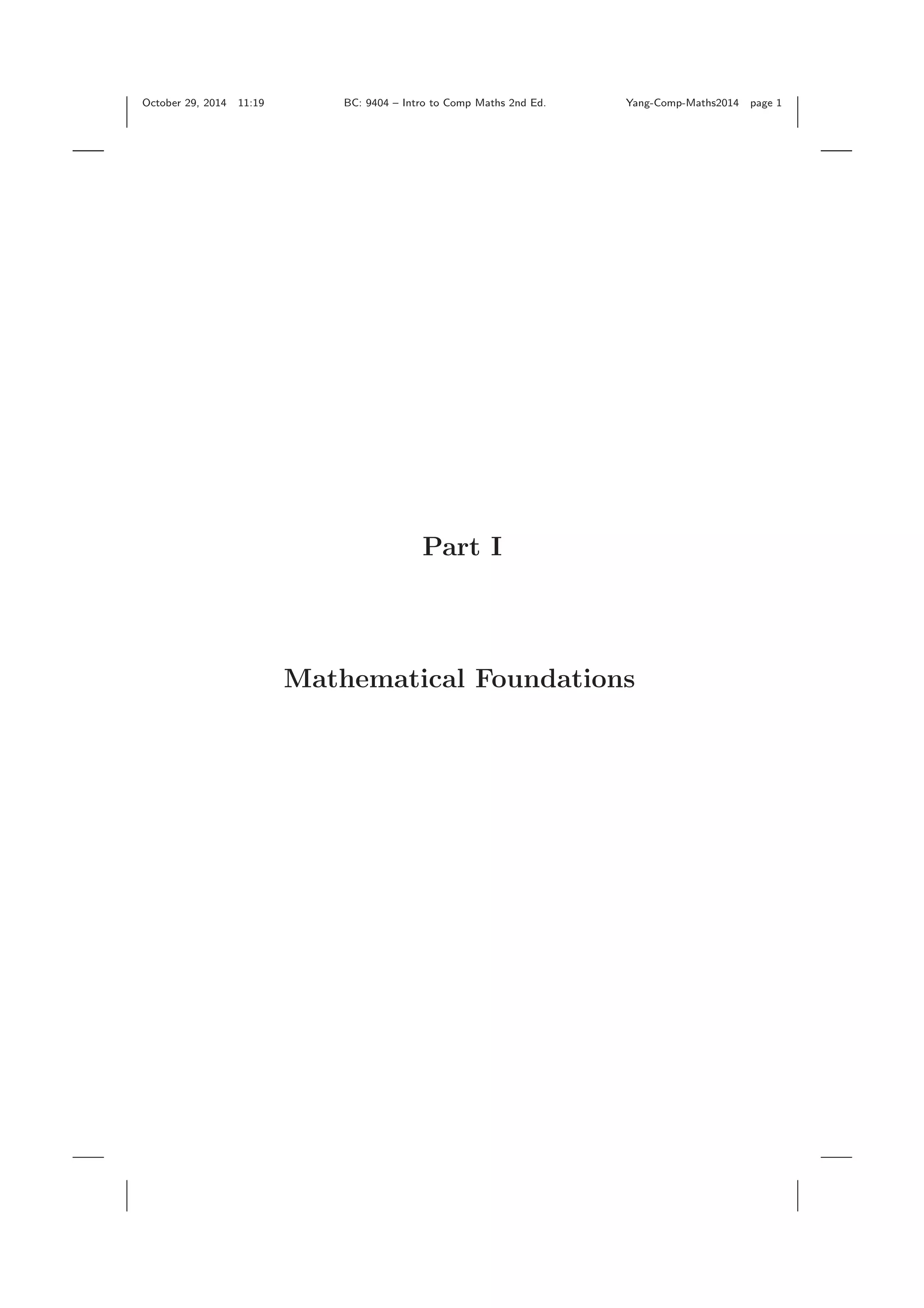



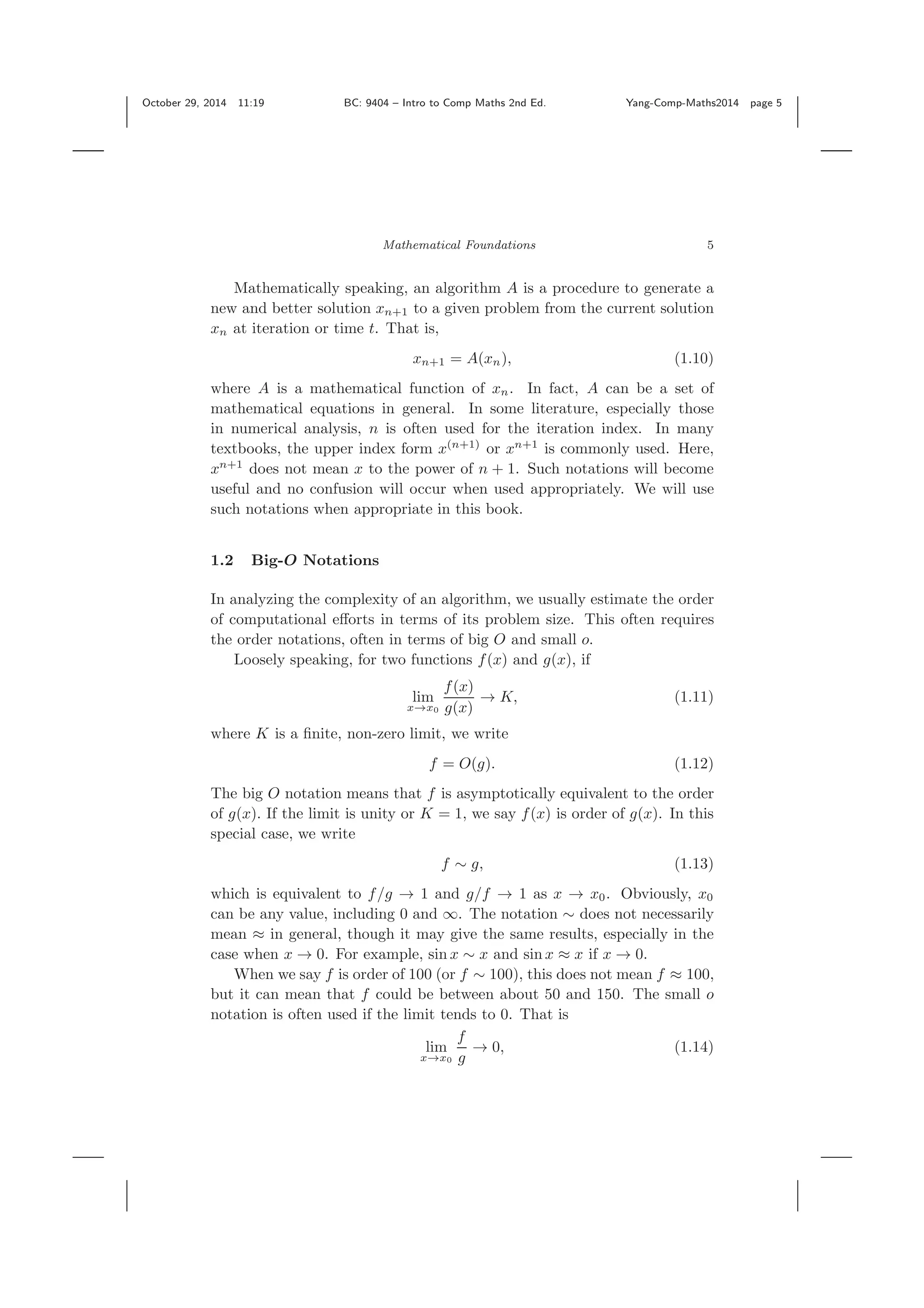
![October 29, 2014 11:19 BC: 9404 – Intro to Comp Maths 2nd Ed. Yang-Comp-Maths2014 page 6 6 Introduction to Computational Mathematics or f = o(g). (1.15) If g > 0, f = o(g) is equivalent to f g. For example, for ∀x ∈ R, we have ex ≈ 1 + x + O(x2 ) ≈ 1 + x + x2 2 + o(x). Example 1.1: A classic example is Stirling’s asymptotic series for facto- rials n! ∼ √ 2πn ( n e )n (1 + 1 12n + 1 288n2 − 139 51480n3 − ...), which can demonstrate the fundamental difference between an asymptotic series and the standard approximate expansions. For the standard power expansions, the error Rk(hk ) → 0, but for an asymptotic series, the error of the truncated series Rk decreases compared with the leading term [here√ 2πn(n/e)n ]. However, Rn does not necessarily tend to zero. In fact, R2 = 1 12n · √ 2πn(n/e)n , is still very large as R2 → ∞ if n 1. For example, for n = 100, we have n! = 9.3326 × 10157 , while the leading approximation is √ 2πn(n/e)n = 9.3248 × 10157 . The difference between these two values is 7.7740 × 10154 , which is still very large, though three orders smaller than the leading ap- proximation. 1.3 Differentiation and Integration Differentiation is essentially to find the gradient of a function. For any curve y = f(x), we define the gradient as f (x) ≡ dy dx ≡ df(x) dx = lim h→0 f(x + h) − f(x) h . (1.16) The gradient is also called the first derivative. The three notations f (x), dy/dx and df(x)/dx are interchangeable. Conventionally, the notation dy/dx is called Leibnitz’s notation, while the prime notation is called Lagrange’s notation. Newton’s dot notation ˙y = dy/dt is now exclusively used for time derivatives. The choice of such notations is purely for clarity, convention and/or personal preference.](https://image.slidesharecdn.com/compmathschapter-150105084355-conversion-gate02/75/Introduction-to-Computational-Mathematics-2nd-Edition-2015-14-2048.jpg)
![October 29, 2014 11:19 BC: 9404 – Intro to Comp Maths 2nd Ed. Yang-Comp-Maths2014 page 7 Mathematical Foundations 7 From the basic definition of the derivative, we can verify that differ- entiation is a linear operator. That is to say that for any two functions f(x), g(x) and two constants α and β, the derivative or gradient of a linear combination of the two functions can be obtained by differentiating the combination term by term. We have [αf(x) + βg(x)] = αf (x) + βg (x), (1.17) which can easily be extended to multiple terms. If y = f(u) is a function of u, and u is in turn a function of x, we want to calculate dy/dx. We then have dy dx = dy du · du dx , (1.18) or df[u(x)] dx = df(u) du · du(x) dx . (1.19) This is the well-known chain rule. It is straightforward to verify the product rule (uv) = uv + vu . (1.20) If we replace v by 1/v = v−1 and apply the chain rule d(v−1 ) dx = −1 × v−1−1 × dv dx = − 1 v2 dv dx , (1.21) we have the formula for quotients or the quotient rule d(u v ) dx = d(uv−1 ) dx = u( −1 v2 ) dv dx + v−1 du dx = v du dx − udv dx v2 . (1.22) For a smooth curve, it is relatively straightforward to draw a tangent line at any point; however, for a smooth surface, we have to use a tangent plane. For example, we now want to take the derivative of a function of two independent variables x and y, that is z = f(x, y) = x2 +y2 /2. The question is probably ‘with respect to’ what? x or y? If we take the derivative with respect to x, then will it be affected by y? The answer is we can take the derivative with respect to either x or y while taking the other variable as constant. That is, we can calculate the derivative with respect to x in the usual sense by assuming that y = constant. Since there is more than one variable, we have more than one derivative and the derivatives can be associated with either the x-axis or y-axis. We call such derivatives partial derivatives, and use the following notation ∂z ∂x ≡ ∂f(x, y) ∂x ≡ fx ≡ ∂f ∂x y = lim h→0,y=const f(x + h, y) − f(x, y) h . (1.23)](https://image.slidesharecdn.com/compmathschapter-150105084355-conversion-gate02/75/Introduction-to-Computational-Mathematics-2nd-Edition-2015-15-2048.jpg)


![October 29, 2014 11:19 BC: 9404 – Intro to Comp Maths 2nd Ed. Yang-Comp-Maths2014 page 10 10 Introduction to Computational Mathematics 1.4 Vector and Vector Calculus Vector analysis is an important part of computational mathematics. Many quantities such as force, velocity, and deformation in sciences are vectors which have both a magnitude and a direction. Vectors are a special class of matrices. Here, we will briefly review the basic concepts in linear algebra. A vector u is a set of ordered numbers u = (u1, u2, ..., un), where its components ui(i = 1, ..., n) ∈ are real numbers. All these vectors form an n-dimensional vector space Vn . A simple example is the position vector p = (x, y, z) where x, y, z are the 3-D Cartesian coordinates. To add any two vectors u = (u1, ..., un) and v = (v1, ..., vn), we simply add their corresponding components, u + v = (u1 + v1, u2 + v2, ..., un + vn), (1.35) and the sum is also a vector. The addition of vectors has commutability (u + v = v + u) and associativity [(u + v) + w = u + (v + w)]. This is because each of the components is obtained by simple addition, which means it has the same properties. u v w b v u a v u Fig. 1.1 Addition of vectors: (a) parallelogram a = u + v; (b) vector polygon b = u + v + w. The zero vector 0 is a special case where all its components are zeros. The multiplication of a vector u with a scalar or constant α ∈ is carried out by the multiplication of each component, αu = (αu1, αu2, ..., αun). (1.36) Thus, we have −u = (−u1, −u2, ..., −un). (1.37) The dot product or inner product of two vectors x and y is defined as x · y = x1y1 + x2y2 + ... + xnyn = n i=1 xiyi, (1.38)](https://image.slidesharecdn.com/compmathschapter-150105084355-conversion-gate02/75/Introduction-to-Computational-Mathematics-2nd-Edition-2015-18-2048.jpg)
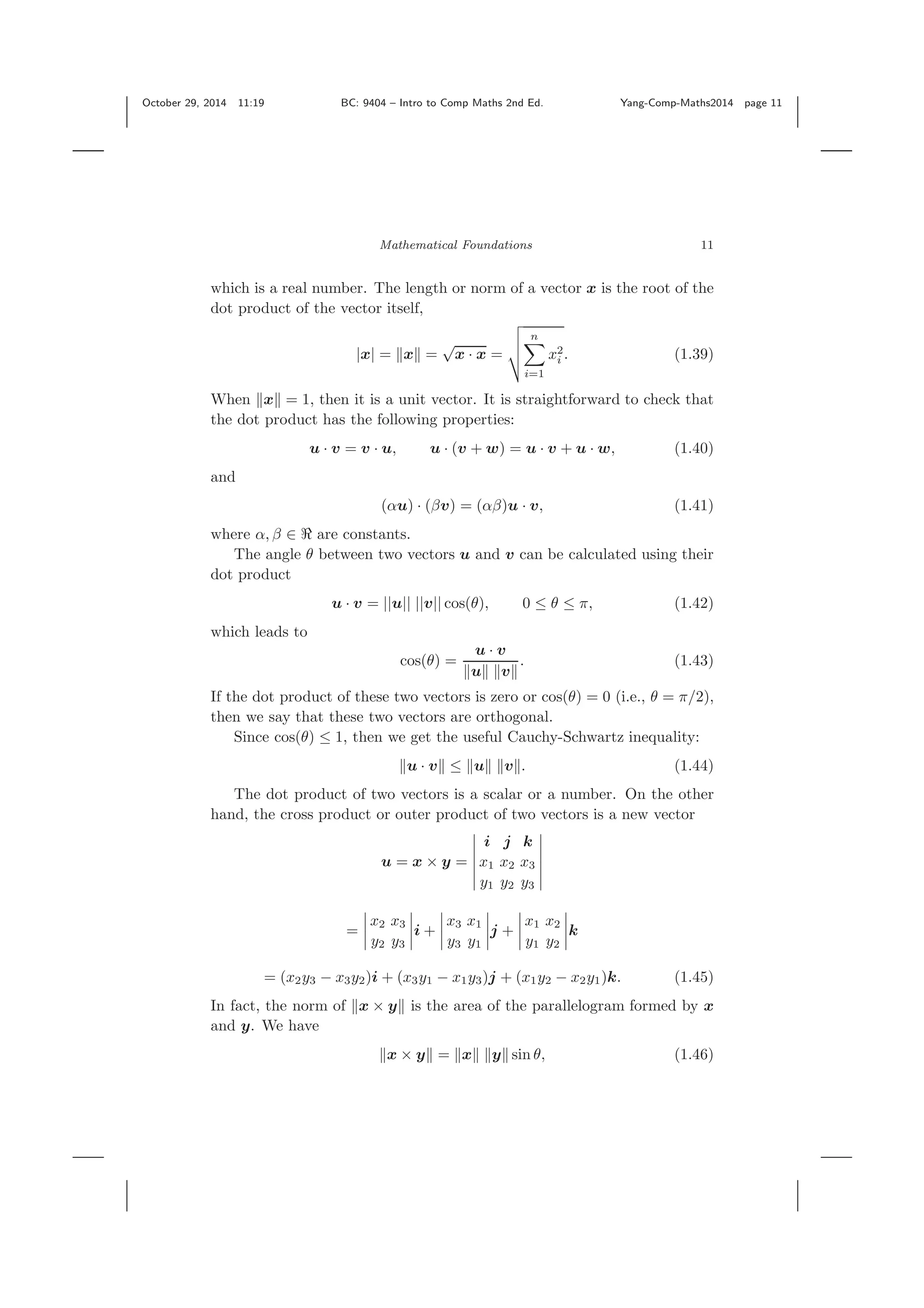
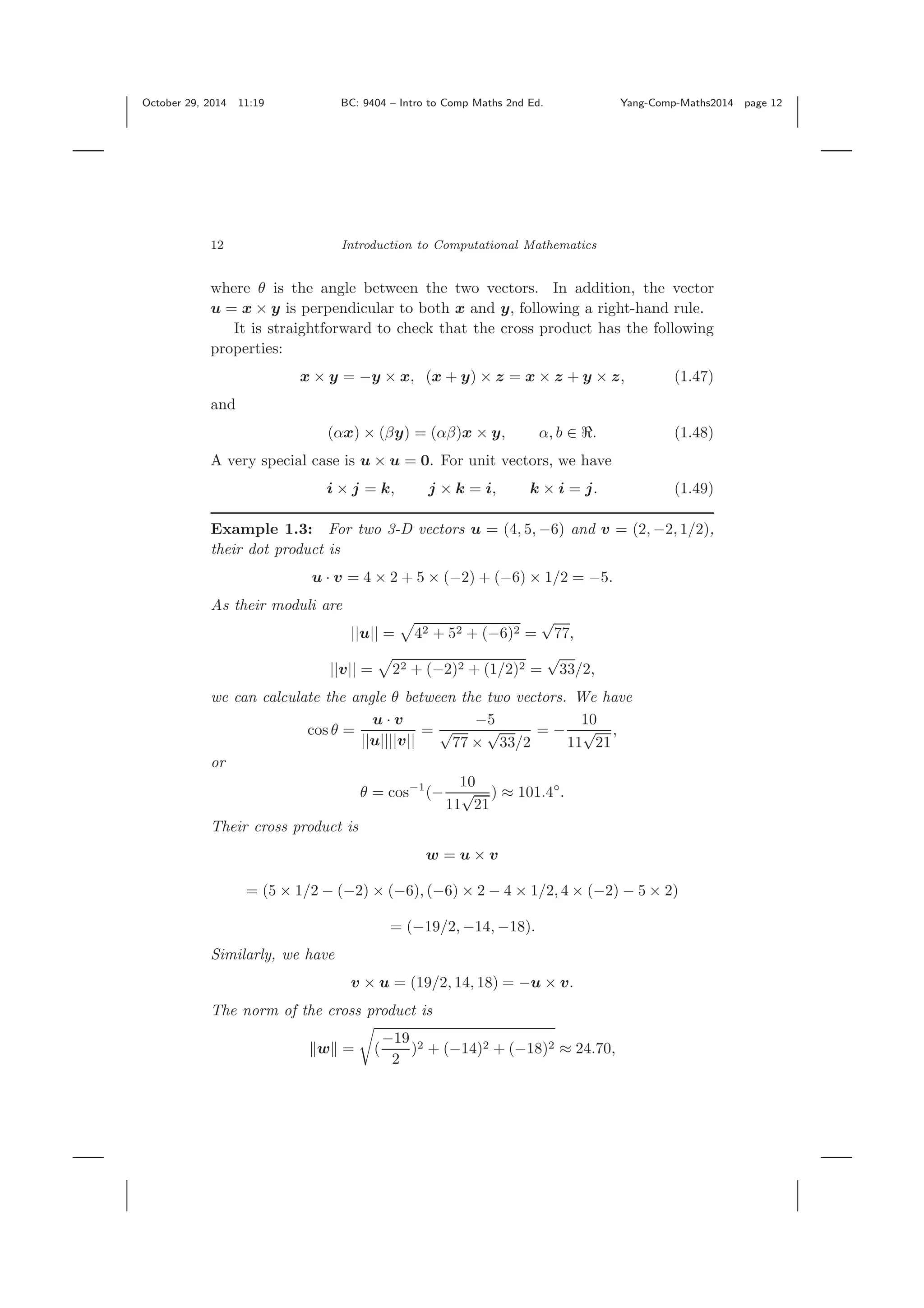
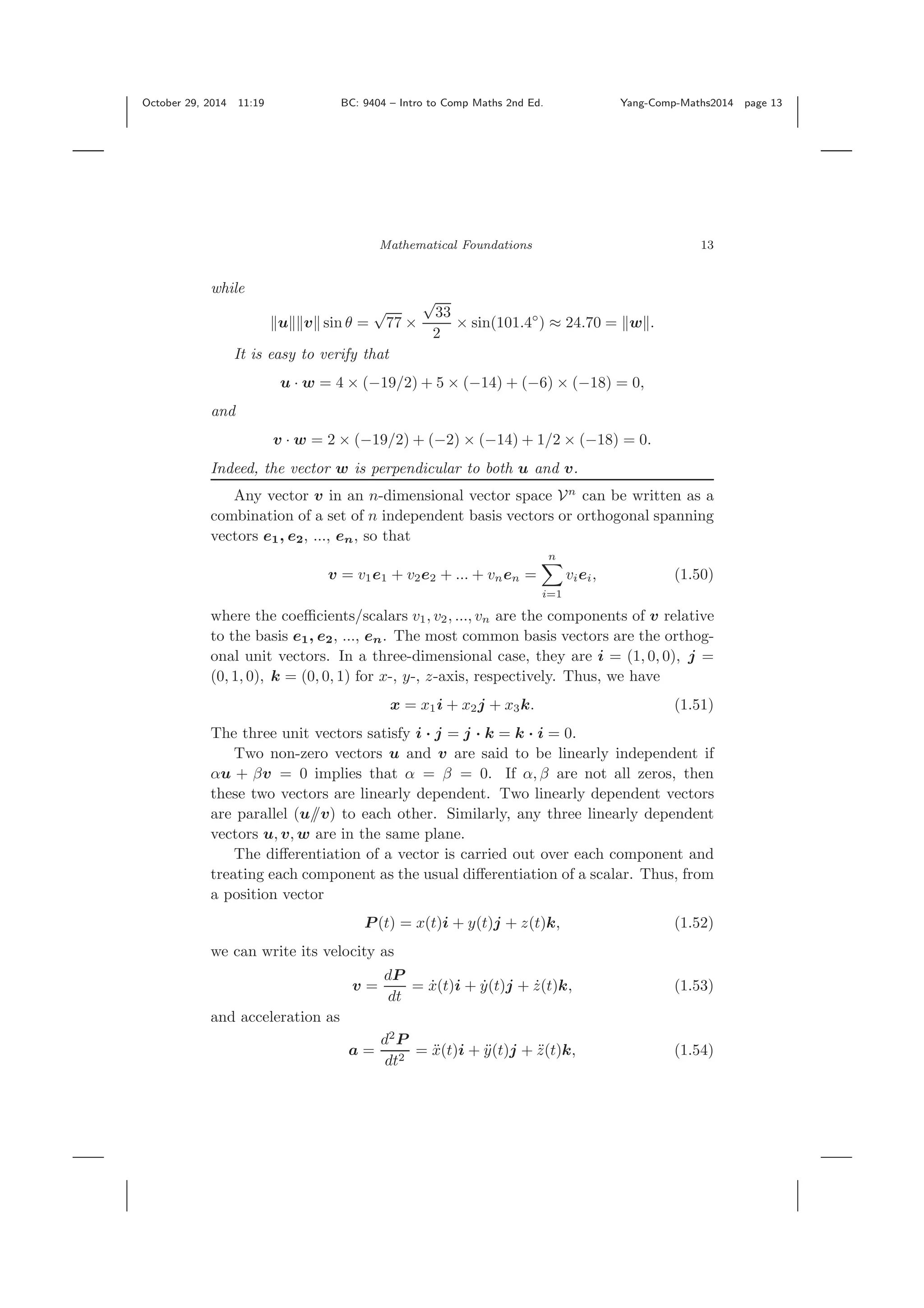
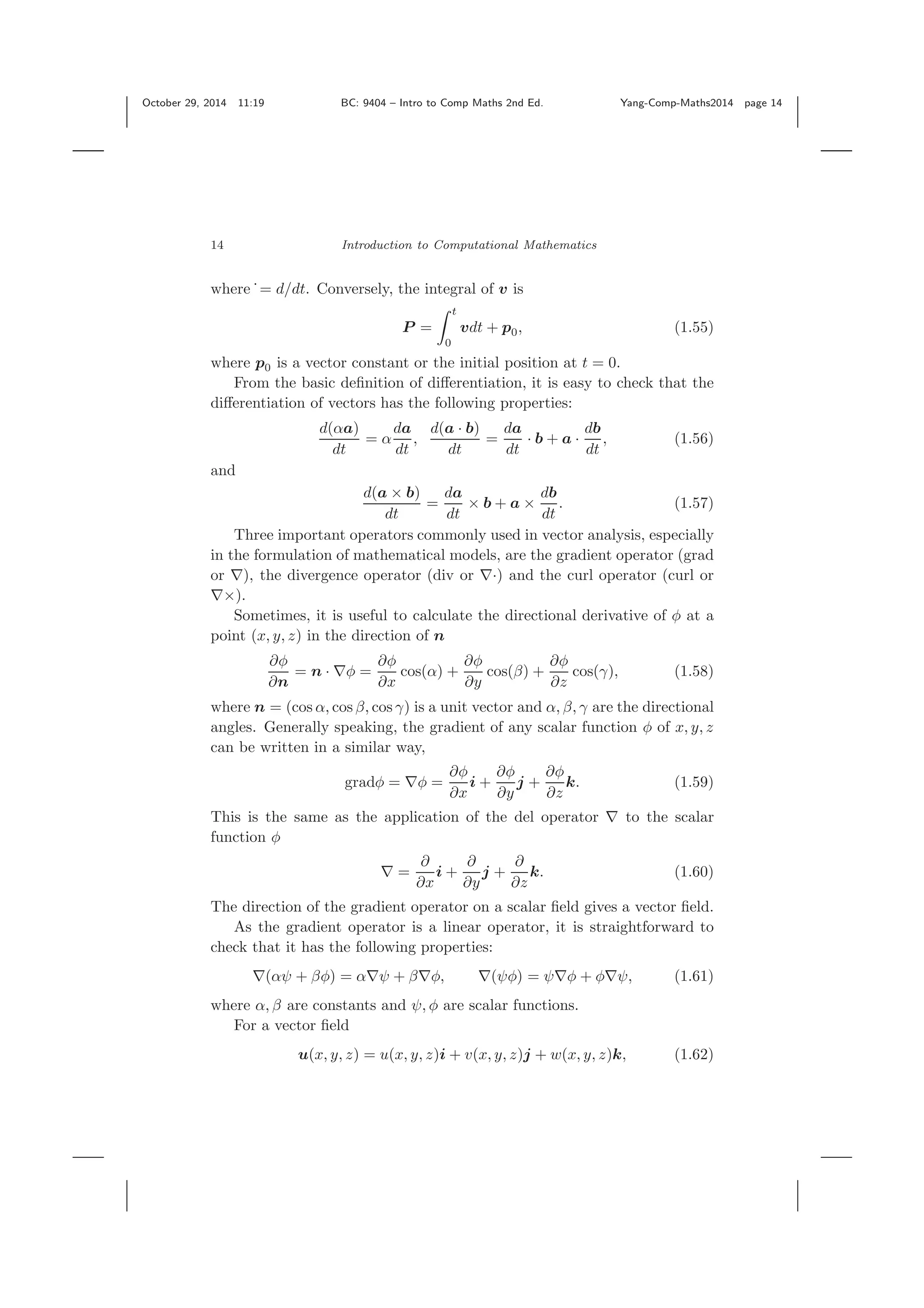
![October 29, 2014 11:19 BC: 9404 – Intro to Comp Maths 2nd Ed. Yang-Comp-Maths2014 page 15 Mathematical Foundations 15 the application of the operator ∇ can lead to either a scalar field or vector field depending on how the del operator is applied to the vector field. The divergence of a vector field is the dot product of the del operator ∇ and u div u ≡ ∇ · u = ∂u1 ∂x + ∂u2 ∂y + ∂u3 ∂z , (1.63) and the curl of u is the cross product of the del operator and the vector field u curl u ≡ ∇ × u = i j k ∂ ∂x ∂ ∂y ∂ ∂z u1 u2 u3 . (1.64) One of the most commonly used operators in engineering and science is the Laplacian operator ∇2 φ = ∇ · (∇φ) = ∂2 φ ∂x2 + ∂2 φ ∂y2 + ∂2 φ ∂z2 , (1.65) for Laplace’s equation Δφ ≡ ∇2 φ = 0. (1.66) Some important theorems are often rewritten in terms of the above three operators, especially in fluid dynamics and finite element analysis. For example, Gauss’s theorem connects the integral of divergence with the related surface integral Ω (∇ · Q) dΩ = S Q · n dS. (1.67) 1.5 Matrices and Matrix Decomposition Matrices are widely used in scientific computing, engineering and sciences, especially in the implementation of many algorithms. A matrix is a table or array of numbers or functions arranged in rows and columns. The elements or entries of a matrix A are often denoted as aij. For a matrix A with m rows and n columns, A ≡ [aij] = ⎛ ⎜ ⎜ ⎜ ⎝ a11 a12 ... a1j ... a1n a21 a22 ... a2j ... a2n ... ... ... ... am1 am2 ... amj ... amn ⎞ ⎟ ⎟ ⎟ ⎠ , (1.68)](https://image.slidesharecdn.com/compmathschapter-150105084355-conversion-gate02/75/Introduction-to-Computational-Mathematics-2nd-Edition-2015-23-2048.jpg)
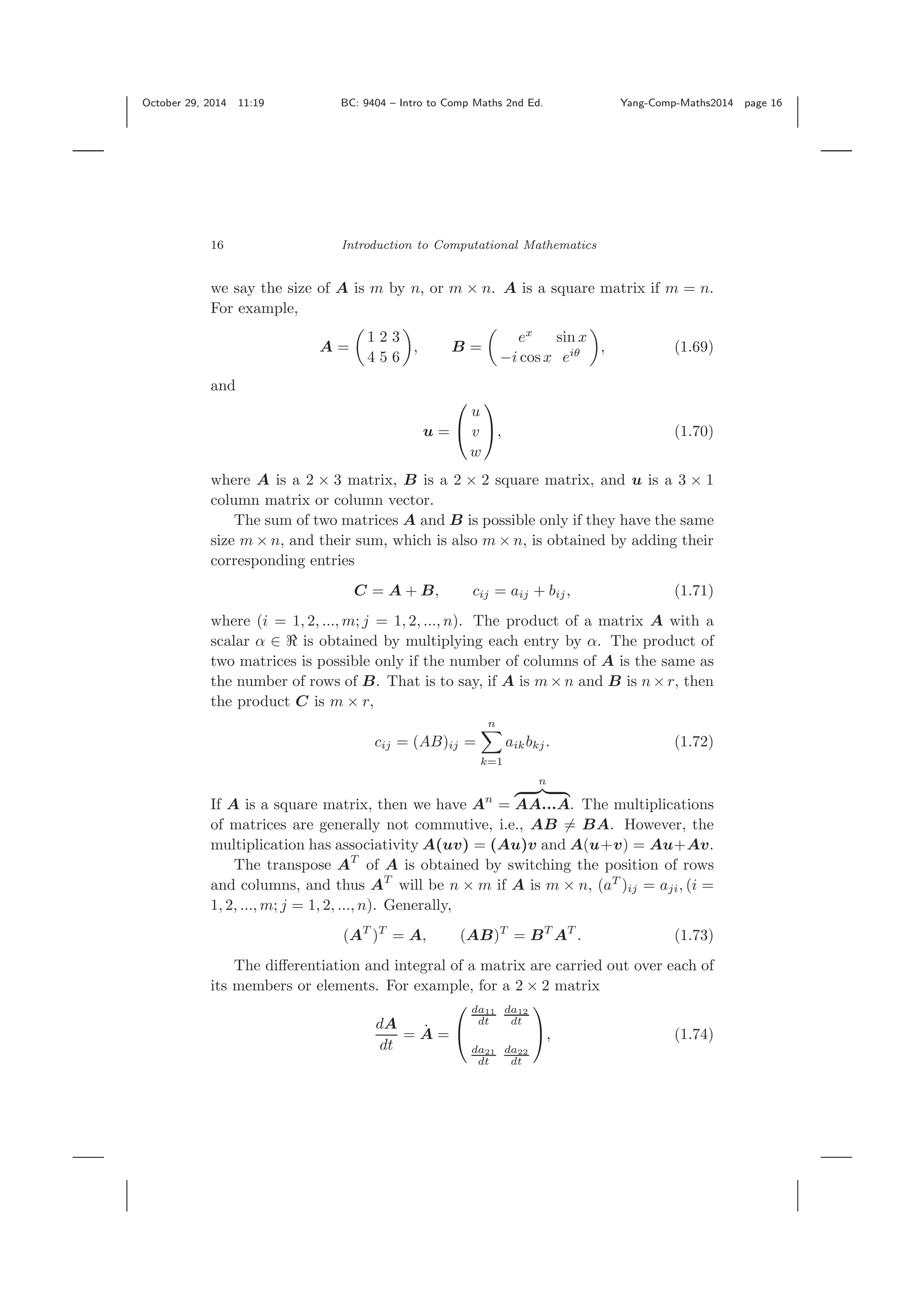

![November 3, 2014 11:34 BC: 9404 – Intro to Comp Maths 2nd Ed. Yang-Comp-Maths2014 page 18 18 Introduction to Computational Mathematics can be written in a compact form in terms of matrices ⎛ ⎝ a11 a12 a13 a21 a22 a23 a31 a32 a33 ⎞ ⎠ ⎛ ⎝ u1 u2 u3 ⎞ ⎠ = ⎛ ⎝ b1 b2 b3 ⎞ ⎠, (1.81) or Au = b. (1.82) This can in turn be written as the following augmented form [A|b] = ⎛ ⎝ a11 a12 a13 b1 a21 a22 a23 b2 a31 a32 a33 b3 ⎞ ⎠ . (1.83) The augmented form is widely used in Gauss-Jordan elimination and linear programming. A lower (upper) triangular matrix is a square matrix with all the ele- ments above (below) the diagonal entries being zeros. In general, a lower triangular matrix can be written as L = ⎛ ⎜ ⎜ ⎜ ⎝ l11 0 ... 0 l21 l22 ... 0 ... ln1 ln2 ... lnn ⎞ ⎟ ⎟ ⎟ ⎠ , (1.84) while the upper triangular matrix can be written as U = ⎛ ⎜ ⎜ ⎜ ⎝ u11 u12 ... u1n 0 u22 ... u2n ... 0 0 ... unn ⎞ ⎟ ⎟ ⎟ ⎠ . (1.85) Any n × n square matrix A = [aij] can be decomposed or factorized as a product of an L and a U, that is A = LU, (1.86) though some decomposition is not unique because we have n2 +n unknowns: n(n + 1)/2 coefficients lij and n(n + 1)/2 coefficients uij, but we can only provide n2 equations from the coefficients aij. Thus, there are n free pa- rameters. The uniqueness of decomposition is often achieved by imposing either lii = 1 or uii = 1 where i = 1, 2, ..., n. Other LU variants include the LDU and LUP decompositions. An LDU decomposition can be written as A = LDU, (1.87)](https://image.slidesharecdn.com/compmathschapter-150105084355-conversion-gate02/75/Introduction-to-Computational-Mathematics-2nd-Edition-2015-26-2048.jpg)
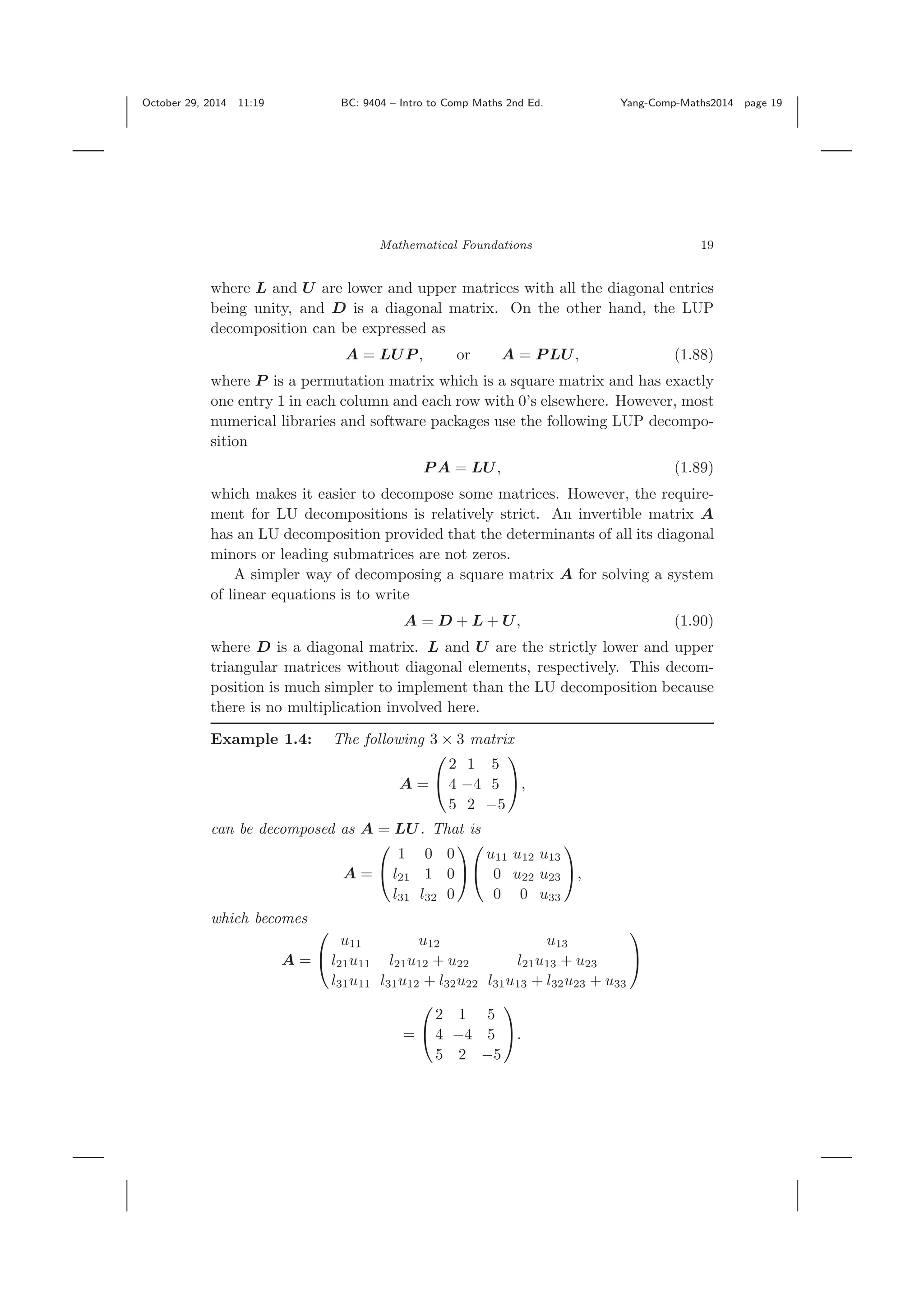
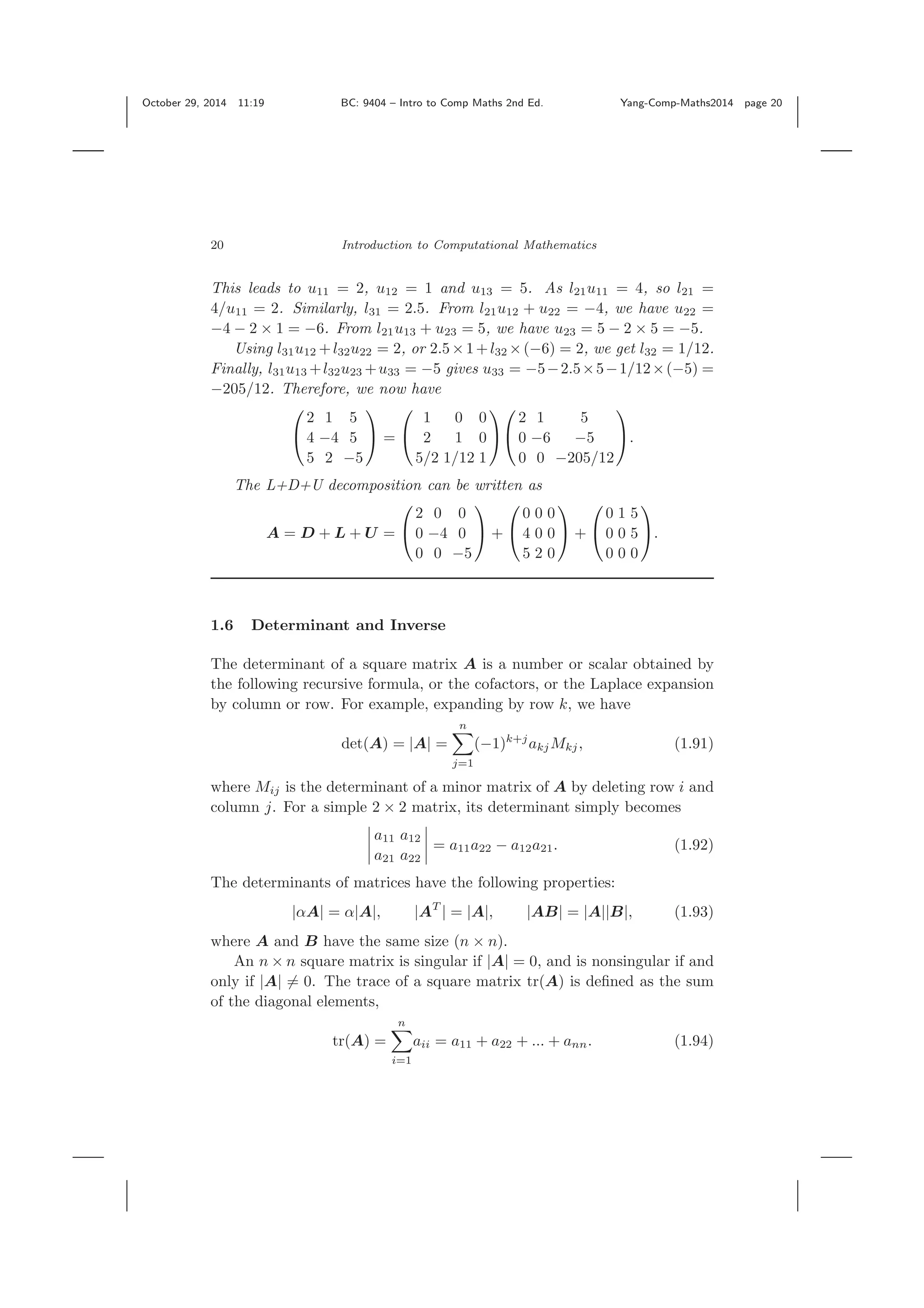
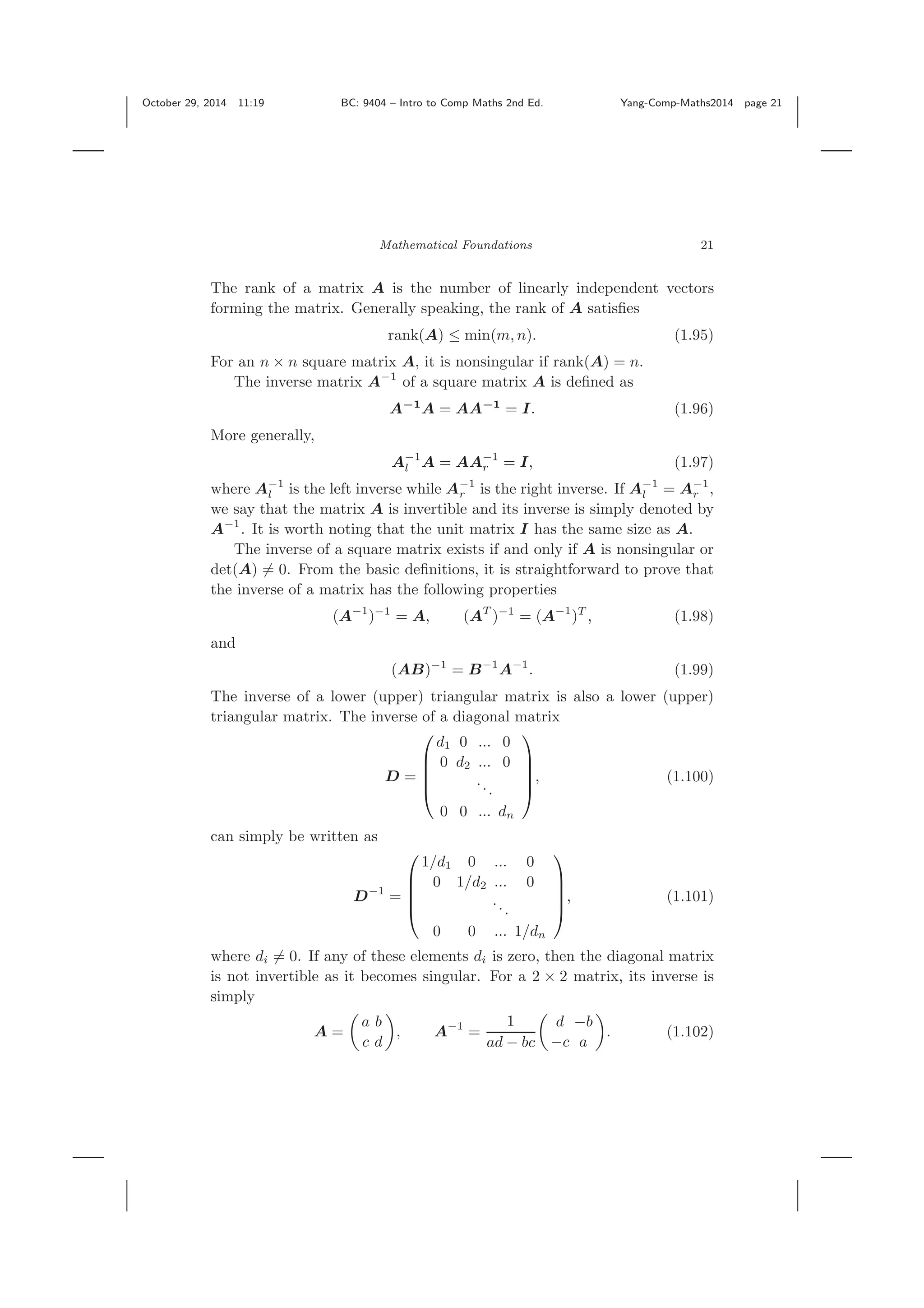

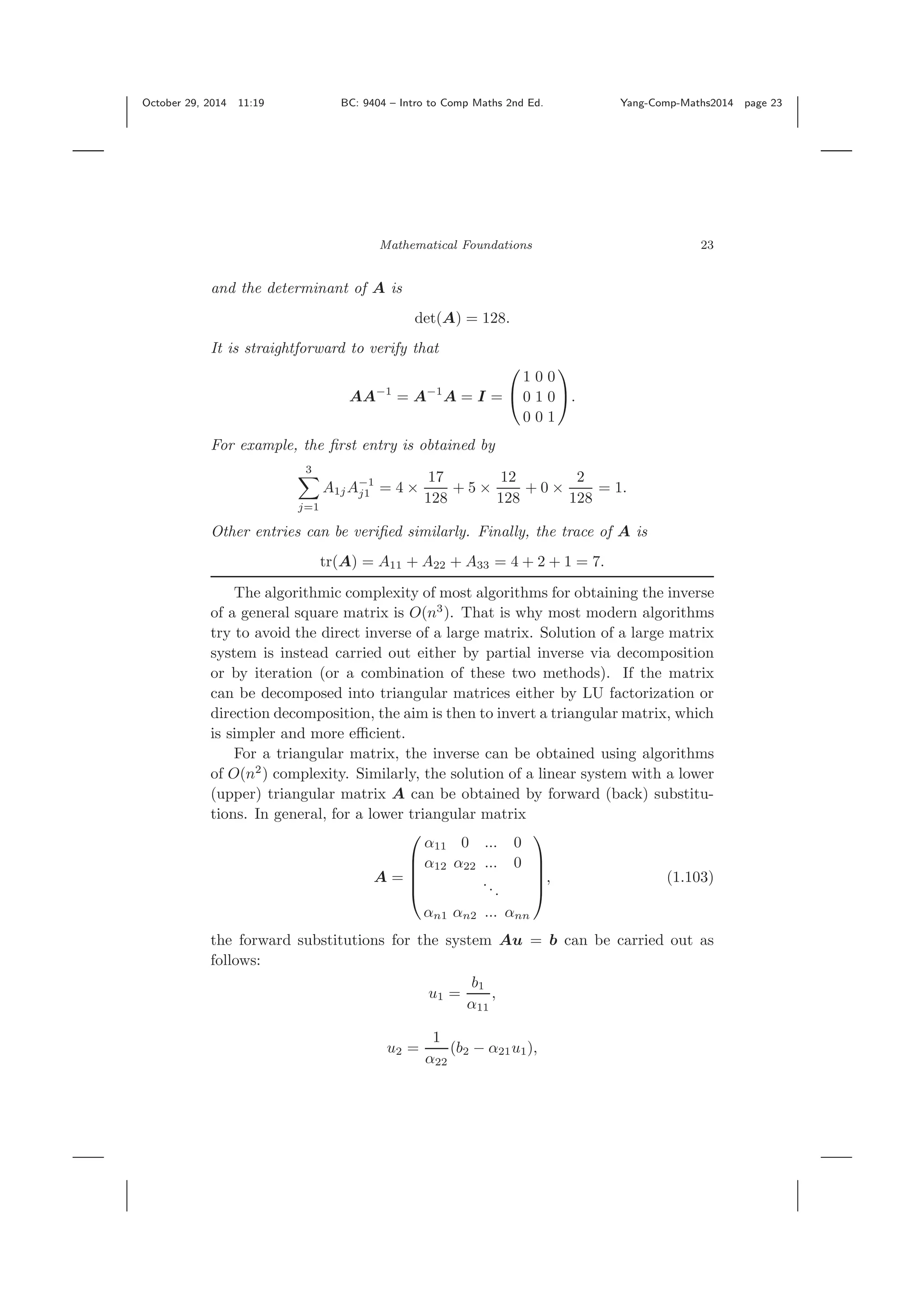
![November 3, 2014 11:34 BC: 9404 – Intro to Comp Maths 2nd Ed. Yang-Comp-Maths2014 page 24 24 Introduction to Computational Mathematics ui = 1 αii (bi − i−1 j=1 αijuj), (1.104) where i = 2, ..., n. We see that it takes 1 division to get u1, 3 floating point calculations to get u2, and (2i− 1) to get ui. So the total algorithmic complexity is O(1 + 3 + ... + (2n − 1)) = O(n2 ). Similar arguments apply to the upper triangular systems. The inverse A−1 of a lower triangular matrix can in general be written as A−1 = ⎛ ⎜ ⎜ ⎜ ⎝ β11 0 ... 0 β21 β22 ... 0 ... βn1 βn2 ... βnn ⎞ ⎟ ⎟ ⎟ ⎠ = B = B1 B2 ... Bn , (1.105) where Bj are the j-th column vector of B. The inverse must satisfy AA−1 = I or A B1 B2 ... Bn = I = e1 e2 ... en , (1.106) where ej is the j-th unit vector of size n with the j-th element being 1 and all other elements being zero. That is eT j = 0 0 ... 1 0 ... 0 . In order to obtain B, we have to solve n linear systems AB1 = e1, AB2 = e2, ..., ABn = en. (1.107) As A is a lower triangular matrix, the solution of ABj = ej can easily be obtained by direct forward substitutions discussed earlier in this section. 1.7 Matrix Exponential Sometimes, we need to calculate exp[A], where A is a square matrix. In this case, we have to deal with matrix exponentials. The exponential of a square matrix A is defined as eA ≡ ∞ n=0 1 n! An = I + A + 1 2! A2 + ..., (1.108) where I is an identity matrix with the same size as A, and A2 = AA and so on. This (rather odd) definition in fact provides a method of calculating](https://image.slidesharecdn.com/compmathschapter-150105084355-conversion-gate02/75/Introduction-to-Computational-Mathematics-2nd-Edition-2015-32-2048.jpg)
